

Addressing the Benefits and Consequences of Tourism in Thailand
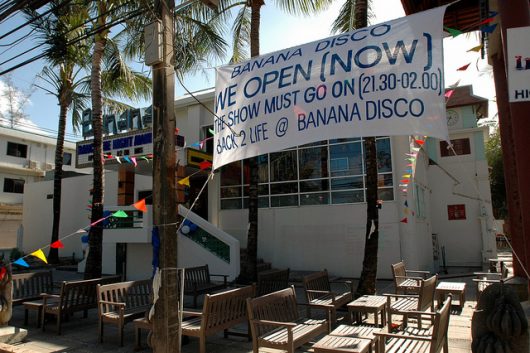
Thailand’s 2004 Tsunami Recovery
Tourism both aided and hindered Thailand in its post-tsunami state. With a high need for jobs and funds, many luxury hotels were able to reopen within months. Unfortunately, some groups such as migrant workers had a difficult time receiving aid, if they even received any at all.
The event was also a catalyst for the marginalization of those in a lower socioeconomic status as many were barred from returning to their homes in popular tourist areas such as the beach. It is estimated that upwards of 10,000 were either prevented from returning or an attempt was made to prevent them from returning.
The Marginalized in Thailand
The country’s social bias against migrant workers, immigrants and refugees is one of Thailand’s biggest criticisms. People in these marginalized groups are at a legal disadvantage compared to Thai citizens. Migrant workers are at the will of their employer, needing a “ termination and employer transfer form ” (in other words, permission from their current employer) in order to switch jobs. Research by the International Labor Organization (ILO) in 2010 found 33 to 50 percent of employers in the fishing, domestic and manufacturing sector used this law to their advantage to prevent losing migrant workers as employees.
There are also multiple reports of migrant workers being punished by law in what seem like uncertain situations. One example is the fourteen migrant workers who filed a complaint against their employer for exploitation , thus damaging the company’s reputation. This resulted in the employer filing a lawsuit against the workers with potential consequences being imprisonment and fines.
Another unfortunate example occurred in 2015 when two migrant workers from Myanmar were sentenced to death for the murder of two tourists; the case was marred by police misconduct such as the mishandling of evidence and the alleged torture of the workers. While it is difficult to find an exact number of migrant workers convicted of a crime in Thailand, it is becoming increasingly clear to the world that this is a human rights issue that needs to be addressed.
Sex Tourism in Thailand
Prostitution was outlawed in the 1960s, but Thailand still has a growing trade revolving around paid sex. There is no way to get a real number on those traveling for sex tourism in Thailand, but NGOs estimated 70 percent of male travelers were visiting specifically for the sex industry in 2013. Prostitution does not have a social stigma in Thailand like in other countries and many Thais have accepted it as part of the culture, creating growth in the industry despite questionable legalities.
Medical Tourism in Thailand
Many tourists travel to Thailand because of the low-cost medical treatment. In 2006, about 200,000 tourists traveled to Thailand explicitly for medical treatment. By 2011, that number rose to half a million .
According to insurance company Thai Expat Club , Thailand was third in the world as the most likely destination for health tourism in 2016. Many medical tourists are saving at least half of what they would pay in the US. Add on recovery by the beach or in a resort and it is no wonder Thailand has become the medical hub of Asia.
Tourism’s Impact on the Environment
With tourism in Thailand increasing, trash increases as well. Unfortunately, Thailand’s infrastructure has been unable to keep up. A common assessment has been waste left over from beach parties. It is estimated that Ko Phangan Full Moon beach parties leave about 12 tons of debris per day behind which mostly goes into landfills or the ocean.
Many groups are currently trying to highlight this issue which will hopefully create a springboard for biodegradable materials and other environmentally conscious decisions. Some of the organizations partnering with Thailand to address the waste issues are the U.S. Environmental Protection Agency, which collaborates with Thailand to protect environmental laws, and the International Union for Conservation of Nature, which works on conservation within the country.
Tourism in Thailand is drawing in great opportunities such as growing jobs, a developing medical field and cultural awareness. However, there are some points of contention with prostitution, the waste problem and an increasing awareness of the marginalized in Thai society. Curbing environmental problems and working toward a more equal society will create a stronger Thailand and, ultimately, a stronger world.
– Natasha Komen Photo: Flickr
“The Borgen Project is an incredible nonprofit organization that is addressing poverty and hunger and working towards ending them.”
-The Huffington Post
Inside the borgen project.
- Board of Directors
Get Smarter
- Global Poverty 101
- Global Poverty… The Good News
- Global Poverty & U.S. Jobs
- Global Poverty and National Security
- Innovative Solutions to Poverty
- Global Poverty & Aid FAQ’s
Ways to Help
- Call Congress
- Email Congress
- 30 Ways to Help
- Volunteer Ops
- Internships
- Courses & Certificates
- The Podcast
- Travel, Tourism & Hospitality ›
- Business Travel
Tourism industry in Thailand - statistics & facts
Domestic tourism, the current state of thailand’s tourism industry, key insights.
Detailed statistics
Foreign tourist arrivals Thailand 2015-2023
Value of tourism GDP Thailand 2017-2021
Value of tourism expenditures Thailand 2017-2021
Editor’s Picks Current statistics on this topic
Travel, Tourism & Hospitality
Share of tourism to GDP value Thailand 2017-2020
Leisure Travel
Number of international visitors Thailand 2023, by region of origin
Further recommended statistics
- Premium Statistic Value of tourism GDP Thailand 2017-2021
- Basic Statistic Number of quarterly foreign visitors Thailand Q1 2021-Q4 2022
- Premium Statistic Number of local tourists Thailand 2023
- Premium Statistic Size of employment in tourism sector Thailand 2017-2021
Total value of the tourism's contribution to the Gross Domestic Product in Thailand from 2017 to 2021 (in billion Thai baht)
Number of quarterly foreign visitors Thailand Q1 2021-Q4 2022
Number of international tourists in Thailand from 1st quarter 2021 to 4th quarter 2022 (in 1,000s)
Number of local tourists Thailand 2023
Number of domestic visitors in Thailand from January to December 2023 (in millions)
Size of employment in tourism sector Thailand 2017-2021
Number of employees in the tourism sector in Thailand from 2017 to 2021 (in millions)
Economic impact
- Premium Statistic Direct contribution of tourism to gross domestic product Thailand 2017-2021
- Premium Statistic Indirect contribution of tourism to gross domestic product Thailand 2017-2021
- Premium Statistic Value of tourism tax Thailand 2017-2021
- Premium Statistic International tourist arrivals revenue Thailand 2023
- Premium Statistic Local tourists revenue Thailand 2023
Direct contribution of tourism to gross domestic product Thailand 2017-2021
Direct contribution of the tourism industry to the gross domestic product (GDP) in Thailand from 2017 to 2021 (in billion Thai baht)
Indirect contribution of tourism to gross domestic product Thailand 2017-2021
Indirect contribution of the tourism industry to the gross domestic product (GDP) in Thailand from 2017 to 2021 (in billion Thai baht)
Value of tourism tax Thailand 2017-2021
Value of tourism tax in Thailand from 2017 to 2021 (in billion Thai baht)
International tourist arrivals revenue Thailand 2023
Tourism revenue incurred from international tourist arrivals in Thailand from January to December 2023 (in billion Thai baht)
Local tourists revenue Thailand 2023
Tourism revenue incurred from domestic visitors in Thailand from January to December 2023 (in billion Thai baht)
- Premium Statistic Number of international visitors Thailand 2023, by region of origin
- Premium Statistic Number of foreign visitors Thailand 2023, by region
- Premium Statistic Revenue generated from foreign visitors Thailand 2023, by region
- Premium Statistic Number of traveling locals Thailand 2023, by region
- Premium Statistic Revenue generated from traveling locals Thailand 2023, by region
Number of foreign tourists in Thailand in 2023, by region of origin (in 1,000s)
Number of foreign visitors Thailand 2023, by region
Total number of foreign visitors in Thailand in 2023, by region (in millions)
Revenue generated from foreign visitors Thailand 2023, by region
Total revenue generated from foreign visitors in Thailand in 2023, by region (in billion Thai baht)
Number of traveling locals Thailand 2023, by region
Total number of Thai travelers within the regions of Thailand in 2023, by region (in millions)
Revenue generated from traveling locals Thailand 2023, by region
Total revenue generated from Thai travelers within the regions of Thailand in 2023, by region (in billion Thai baht)
Accommodation
- Premium Statistic Share of foreign visitors to total guests of accommodations Thailand 2015-2023
- Premium Statistic Share of foreign visitors to total guests of accommodations Thailand 2023, by region
- Premium Statistic Advance reservation rate of accommodations Thailand 2015-2023
- Premium Statistic ADR of accommodations Thailand 2015-2023
- Premium Statistic Popular accommodations for Thais when travelling Thailand Q2 2021
Share of foreign visitors to total guests of accommodations Thailand 2015-2023
Proportion of international tourists to total guests of the accommodations in Thailand from 2015 to 2023
Share of foreign visitors to total guests of accommodations Thailand 2023, by region
Proportion of international tourists to total guests of the accommodations in Thailand in 2023, by region
Advance reservation rate of accommodations Thailand 2015-2023
Share of 3-month advanced reservations on the total accommodation occupancy rate in Thailand from 2015 to 2023
ADR of accommodations Thailand 2015-2023
Average daily rate (ADR) of accommodations in Thailand from 2015 to 2023 (in thousand Thai baht)
Popular accommodations for Thais when travelling Thailand Q2 2021
Accommodations that Thais planned to stay at when travelling in Thailand in 2nd quarter 2021
Tourist perspectives
- Premium Statistic Ideal travel destinations in Asia among Thais 2023
- Premium Statistic Online travel agency usage Thailand 2023
- Premium Statistic Most used online travel agencies Thailand 2023
- Premium Statistic Most common duration before a trip to purchase travel tickets on OTAs Thailand 2023
- Premium Statistic Reasons for using online travel agencies for purchasing tickets Thailand 2023
- Premium Statistic Reasons for not using online travel agencies for purchasing tickets Thailand 2023
Ideal travel destinations in Asia among Thais 2023
Leading travel destinations in Asia among tourists in Thailand as of January 2023
Online travel agency usage Thailand 2023
Online travel agency usage in Thailand as of June 2023
Most used online travel agencies Thailand 2023
Leading online travel agencies in Thailand as of June 2023
Most common duration before a trip to purchase travel tickets on OTAs Thailand 2023
Most common duration before a trip to purchase travel tickets on online travel agencies (OTAs) in Thailand as of June 2023
Reasons for using online travel agencies for purchasing tickets Thailand 2023
Reasons for using online travel agencies for purchasing tickets or services in Thailand as of June 2023
Reasons for not using online travel agencies for purchasing tickets Thailand 2023
Reasons for not using online travel agencies for purchasing tickets or services in Thailand as of June 2023
Further reports
Get the best reports to understand your industry.
- Tourism and hotel industry in Singapore
- Tourism in Malaysia
- Travel and tourism in Indonesia
- Tourism industry in Vietnam
Mon - Fri, 9am - 6pm (EST)
Mon - Fri, 9am - 5pm (SGT)
Mon - Fri, 10:00am - 6:00pm (JST)
Mon - Fri, 9:30am - 5pm (GMT)
Reimagining travel: Thailand tourism after the COVID-19 pandemic
Thailand’s economy is reliant on international tourism, a once-flourishing sector that has been impacted by pandemic restrictions. But there have been continual government efforts to boost domestic travel, and measures to support returning international demand after Thailand began reopening to vaccinated international travelers from 63 countries on November 1, 2021. 1 Pasika Khernamnuoy and Katie Silver, “Thailand reopens to vaccinated tourists from over 60 nations,” BBC, November 1 2021, bbc.com. Even as the world addresses emerging variants of the virus, Thailand’s lessons can act as a guide for other tourism-dependent countries facing similar dilemmas as they prepare for the resurgence of international travel.
A heavy blow, adjustments needed to support recovery
In 2019, Thailand ranked eighth globally in international tourist arrivals, with China being a key source market. 2 United Nations World Tourism Organization (UNWTO). Thailand recorded a high of 40 million visitors in 2019, with the top three spending categories for inbound visitors that year being in accommodation (28 percent), shopping (24 percent of spending), and food and beverages (21 percent). 3 “Summary of tourism income and expenses from foreign tourists entering Thailand in 2019,” Ministry of Tourism & Sports, October 28, 2020, mots.go.th. Furthermore, the Thai tourism sector created 36 million jobs between 2014 and 2019. 4 “Dashboard SME big data,” Office of Small and Medium Enterprises Promotion, accessed October 2021, sme.go.th.
Unfortunately, the pandemic and related restrictions have hit travel particularly hard, as international travel plunged. Passengers on international flights to Thailand dropped by 95 percent in September 2021, compared to the previous year. Hotels, in turn, only filled 9 percent of their rooms (Exhibit 1).
This decline in visitors had an outsize impact on tourism spending, as international travelers spent significantly more than their local counterparts (Exhibit 2). For instance, in 2019, international travelers made up 33 percent of overall travelers in Thailand yet accounted for almost 60 percent of all tourism spending—international tourists spent $1,543 per traveler on average, compared to $152 by domestic travelers. 5 “Tourism statistics 2019,” Ministry of Tourism & Sports, accessed October 2021, mots.go.th. This drop in expenditure undoubtedly caused a ripple effect on Thailand’s food and beverage retail industries, which include 1.2 million small and medium-size enterprises (SMEs). 6 “How to start business,” Office of Small and Medium Enterprises Promotion, accessed October 2021, sme.go.th.
Recovery appears to be on the horizon for Thailand. Assuming virus recurrence, slow long-term growth, muted world recovery, and minimal changes to global tourism strategies, Thailand’s tourism sector could only recover to pre-crisis levels by 2024.
Given that Thailand’s GDP relies significantly on foreign tourism income, the domestic tourism market alone is not sufficient to bring the nation’s tourism revenue back to 2019 figures; the sector’s recovery would depend on a resurgence in international travel (Exhibit 3). Globally, this recovery scenario would likely reshape the landscape of the world’s travel industry and create a strong imperative for both the public and private sectors to act to ensure the industry’s survival.
Efforts to stimulate tourism
Thailand has deployed various efforts to compensate for the loss of inbound tourism. Given that for most of the first quarter of 2020, Thailand saw less than 1,000 daily COVID-19 cases nationwide, with cases not rising above 4,000 until November 2020, domestic tourism was still a viable option for travelers. The Thai government’s attempt to boost domestic travel took the form of providing subsidies for hotel stays and flights for travelers. The government also rolled out measures to stimulate international travel to Thailand’s beach destinations and attract high-end travelers from international markets.
Travel together—stimulating domestic tourism
In August 2020, the Thai government launched the Rao Tiew Duay Gun (We Travel Together) program, where it set aside a budget of $640 million to help boost domestic tourism. 7 “Thailand approves domestic tourism package worth 22.4 billion baht,” Tourism Authority of Thailand Newsroom, June 17, 2020, tatnews.org.
The government subsidized a total of six million nights of hotel accommodation at 40 percent of normal room rates. The subsidy was capped at 3,000 baht ($100) per night for up to five nights. Subsidies for other services, including food, were capped at 600 baht ($20) per room per night. This subsidy was initially limited to facilities outside tourists’ home provinces, but that restriction was lifted in the second phase of the rollout in December 2020. In addition, domestic tourists traveling by air would qualify for a government refund of 40 percent of the ticket price. This was capped at 1,000 baht ($32) per seat, with a quota of 2 million seats.
The program reached its total quota of six million hotel-room nights in February 2021, seven months after its launch. 8 “FPO reveals the money we travel together, 20,000 million,” Bangkok Business News , January 4, 2021, bangkokbiznews.com; “‘We travel together’ the parade has already reserved 6 million rights. But there are still 1.35 million rights left!” Bangkok Business News , February 8, 2021, bangkokbiznews.com. During that time, at least $1 billion had been added to the Thai economy. 9 “NESDB-TAT has not yet knocked on ‘we travel together, phase 3,’” Thai PBS News , March 16, 2021, news.thaipbs.or.th.
Many operators grasped this opportunity, shifted their focus to the domestic market, and attracted local travelers by promoting flights and hotels in collaboration with the We Travel Together campaign. Destinations that once served mainly international visitors welcomed more local travelers, which has helped their economies wade through this difficult period. Many luxury hotels offered deep discounts and attractive promotions to capture the medium- to high-spend domestic-tourist segment.
These efforts to stimulate domestic travel were temporarily paused as COVID-19 cases reached a new high in July 2021. Domestic air travel in and out of red zones, including Bangkok, was banned during July to September 2021 in response to the nation’s effort to control the spread of the Delta variant. 10 “Domestic flight bans in force,” Bangkok Post , July 21, 2021, bangkokpost.com. Phase three of the We Travel Together campaign was paused during the same period, but resumed in October 2021.
Bringing back international travelers with the ‘sandbox’ approach
Despite promotional efforts for domestic travel, Thailand’s total revenue from domestic travel still saw a significant dip. The country’s revenue from domestic travel dropped from $34.5 billion to $15.4 billion in 2020. An increase in domestic spending alone would not compensate for the impact of the pandemic on the Thai economy. The country has largely been dependent on international markets, which represented about $62 billion or 60 percent of total tourism spend in 2019. 11 “Tourism statistics 2019,” Ministry of Tourism & Sports, accessed October 2021, mots.go.th.
In response, Thailand launched the “Phuket Sandbox” in July 2021, an effort to recapture demand from international travelers. The initiative offered fully vaccinated travelers (between 14 days and one year before their travel date) exemption from quarantine, provided they remain in Phuket for at least 14 days before traveling to other parts of Thailand. 12 “General information—Phuket Sandbox,” Tourism Authority of Thailand Newsroom, October 1, 2021, tatnews.org. Additionally, travelers’ stay in Phuket was restricted to accommodation establishments that have been certified by the Safety & Health Administration of the Thai government. Visitors staying in Phuket for less than 14 days were permitted to leave Phuket only if their destination was outside of Thailand.
The model hoped to draw visitors during the year-end season in Asia, Europe, and America—all key origin markets for Thailand. Several other reopening plans followed, including the “Samui Plus” and “Andaman Sandbox” plans. 13 “Samui Plus plan to generate B180m,” Bangkok Post , July 18, 2021, bangkokpost.com; “‘Adaman Sandbox’ next on govt agenda,” Bangkok Post , July 21, 2021, bangkokpost.com. Together, the schemes created a network of reopened destinations, which hoped to position Thailand as an attractive destination for international and domestic travelers alike.
The economic uplift from the Phuket Sandbox were moderate. In the period from July 1 to August 31, Phuket welcomed about 26,400 visitors, who were estimated to have spent at least $48.8 million while staying on the resort island (Exhibit 4). 14 “Phuket Sandbox generates B1,634m in two months,” Bangkok Post , September 5, 2021, bangkokpost.com.
A nationwide rise in COVID-19 infection rates in the same period meant that the government had to reconsider social distancing and other measures to minimize risk to visitors.
In any case, Thailand has gathered its learnings from the “sandbox” approach and proceeded to reopen the country to receive international travelers. As of November 1, 2021, the Thai government commenced a phased reopening of the country, allowing fully vaccinated tourists from 63 low-risk countries to visit with one day of quarantine, provided they pass a COVID-19 test upon arrival. The government has also replaced the slow-paced Certificate of Entry (COE) system with the Thailand Pass System, in an effort to make the documentation process of travelers entering Thailand more efficient than the COE application. 15 “Thailand pass,” ThaiEmbassy.com, accessed on November 1, 2021, thaiembassy.com.
The program also expanded the number of provinces open to international visitors to 17, including major tourism destinations such as Bangkok and Chiang Mai. Subject to readiness, additional major provinces are expected to reopen from December 2021 onwards. To ensure visitor safety, some COVID-19 measures remain in place, although most businesses have been allowed to reopen and nighttime curfews have been lifted in almost every province. The reopening has welcomed tourists globally, with top visitors coming from Thailand’s key source markets—the United States, Germany, and the United Kingdom (Exhibit 5).
Attracting ‘quality’ travelers, with an eye on new markets
Pre-COVID-19, China was one of the main contributors to Thailand’s tourism income, accounting for more than 27 percent of 2019 tourism receipts. 16 “Tourism statistics 2019,” Ministry of Tourism & Sports, accessed October 2021, mots.go.th. Given the current prudent approach of the Chinese government toward international travel, the road of return for Chinese visitors to Thailand will be a long one. China’s international-flight seat capacity and passenger numbers remain down by 95 percent compared to pre-COVID-19 levels, and stringent public-health measures for international travel remain in place. Thailand, therefore, needs to reimagine its strategy and try to capture new sources of international travelers in markets where there are more rapid recoveries of international travel demand.
The situation may change rapidly, particularly in these volatile times; closely monitoring the revival of these top source markets, particularly around the country’s stance towards viral control measures, will help industry players plan their recovery efforts and capture untapped value.
Recognizing these shifting traveler trends, and the resilient nature of premium traveler groups, the Thai government is striving to attract “quality” travelers from these source countries. Measures include revisiting and relaxing certain regulations—such as yachting regulations and taxes on personal belongings and luxury goods—to improve and stimulate the premium travel experience.
Taking this a step further, the Thai government is preparing to launch a long-term residence program to attract foreigners to the country through new Long-Term Resident (LTR) visas (up to ten years), tax and investment incentives, foreigners’ residential property ownership relaxations, and more. The program will target four key personas: the wealthy global citizen, the wealthy retiree, the work-from-Thailand professional, and the high-skilled professional. The country’s ambition is to welcome over one million of these target personas and generate over 1 trillion baht in domestic spending in the next five years, beginning in 2022.
Emerging from the storm: Actions for travel and tourism
Thailand has put innovative measures in place to help its vitally important travel and tourism sector wade through the COVID-19 crisis. As new variants of the coronavirus emerge, health and safety should remain the foremost priority as countries contemplate their travel programs. Once it is safe to do so, there are actions that stakeholders can take to steer into and thrive within the next normal.
Adjust offerings and pricing strategy to meet market needs. Hotels, tour operators, restaurants, and transport providers could look to explore opportunities to offer services and products that meet new travel demands.
Bundle products, such as hotel and flights, offer upselling and cross-selling opportunities as well as a diversified revenue stream.
Travel companies could also devise and deploy targeted pricing strategies to drive long-term loyalty and stickiness for when international travel fully returns. Given the phased reopening of popular provinces in Thailand, and the inclusion of more visitors from select countries on a quarantine-exemption list, travel companies can leverage data on traveler behaviors to set the right prices and conduct targeted campaigns by country of origin and destination.
Explore opportunities within the mass-affluent traveler segment. Focusing on premium travel experiences may be a viable strategy in some markets, but it may have limited impact in Thailand. Given that the top three inbound visitor-spending categories in 2019 were shopping, accommodations, and food, targeting the high-end market would only benefit a small segment of travel companies and would not contribute to the country’s economic recovery across all relevant sectors.
By promoting more differentiated travel experiences and attractions such as ecotourism and cultural tourism, which are naturally location based and sought after by younger mass-affluent travelers, operators could contribute to greater aviation and transportation use in Thailand.
Form partnerships across the travel ecosystem. As a result of the government’s We Travel Together program, which subsidizes travel through a digital redemption mechanism (the Pao Tang app), the country has seen an estimated 30 to 40 million users join and use the platform. 17 Krung Thai Bank equity research, April 2021. This has created an opportunity for domestic consumer data to be collected and analyzed to provide more personalized tourism offerings that consumers are more likely to consider spending on.
Taking this a step further, tour operators, restaurants, and shopping malls might link up, creating a connected ecosystem where a traveler could be strategically engaged through multiple personalized services, products, and loyalty programs along their journeys.
Expand the network of destinations. There is an opportunity to offer travelers a wider variety of destinations in first- and second-tier cities, such as Nakhon Si Thammarat, Chiang Rai, Nakhon Nayok, Ratchaburi, and Loei. These locations have been able to sustain visitor numbers at a relatively low rate of decline, largely due to domestic travelers looking for new places to visit during international travel restrictions.
With a boost in promotion and appropriate infrastructure investment, tourism will not only contribute to the survival of the industry in these cities, but it could also lead to enduring tourist appeal that extends beyond domestic traveler groups, especially with the gradual return of international visitors. For example, the Tourism Authority of Thailand is collaborating with airlines to offer direct flights to alternative second-tier tourism destinations.
Leverage digital to connect, attract, and retain travelers. Travel companies can digitalize the customer journey from check-in through payment, including the provision of maps and information. Traveler preferences can be tracked in real time to design better and more relevant offerings, while digital booking channels can target different customer segments. Digital marketing can also entice visitors to return and to share their experiences on social media.
For instance, the Tourism Council of Thailand is working with Singapore-based IsWhere to deploy a digital-marketing platform for tourism business operators to better connect and engage with a potentially sizeable number of domestic and international travelers; the platform’s prior partnership with a major tech company has enabled it to reach 600 million digital customers worldwide.
Reimagine support needed by industry players. In the short term, industry players would need stimulus, support, and guidance on health and safety policies from the government. In the medium term, small and medium-size players would benefit from the government’s support in adjusting to online travel services and digital marketing, such as a one-stop digital platform to connect industry players with international travelers.
As such, the Tourism Authority of Thailand announced its plan to establish a private digital firm to work on creating a digital infrastructure for tourism, utilize big data in the industry, and potentially introduce blockchain-based e-vouchers and nonfungible tokens to provide tourism operators with more options for reaching travelers online and offline.
In the wake of the COVID-19 pandemic, tourism recovery in Thailand will be gradual and complex and requires varied strategies from both industry and government. As the world eagerly prepares for the eventual revival of international travel, Thailand and other countries can draw important lessons from its experience during this difficult interim period.
Steve Saxon is a partner in McKinsey’s Shenzhen office; Jan Sodprasert is a partner in the Bangkok office, where Voramon Sucharitakul is an associate partner.
The authors wish to thank Margaux Constantin , Kamila Dolinska, Steffen Köpke, Alan Laichareonsup, Jason Li, Georgie Songsantiphap, and Jackey Yu for their contributions to this article.
Explore a career with us
Related articles.
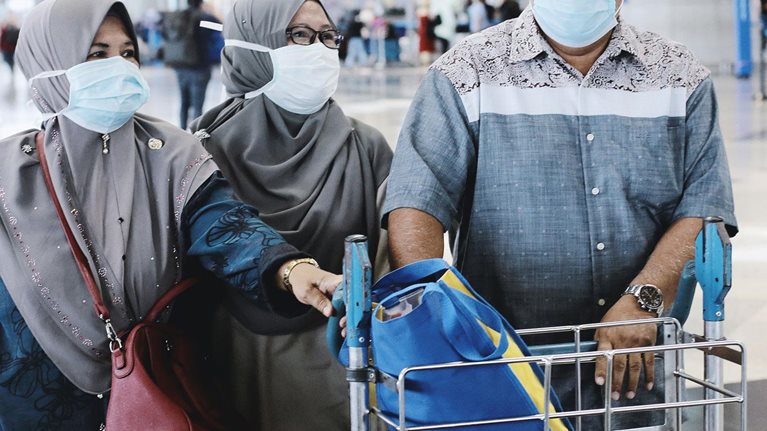
Reimagining the $9 trillion tourism economy—what will it take?

Make it better, not just safer: The opportunity to reinvent travel
A new approach in tracking travel demand
Customer Logins
Obtain the data you need to make the most informed decisions by accessing our extensive portfolio of information, analytics, and expertise. Sign in to the product or service center of your choice.
- S&P Dow Jones Indices
- S&P Global Market Intelligence
- S&P Global Mobility
- S&P Global Commodity Insights
- S&P Global Ratings
- S&P Global Sustainable1
- Investor Relations Overview
- Investor Presentations
- Investor Fact Book
- News Releases
- Quarterly Earnings
- SEC Filings & Reports
- Executive Committee
- Corporate Governance
- Merger Information
- Stock & Dividends
- Shareholder Services
- Contact Investor Relations
- Email Subscription Center
- Media Center

Thailand’s tourism sector drives economic recovery

Executive Director and Asia-Pacific Chief Economist, S&P Global Market Intelligence
Thailand has shown a gradual economic recovery from the COVID-19 pandemic during 2022, helped by rising international tourism arrivals. Real GDP growth rose from 1.5% in 2021 to 2.6% in 2022, with growth momentum expected to improve further in 2023.
The latest S&P Global Thailand Manufacturing PMI survey results for February 2023 continued to signal expansionary conditions for manufacturing output and new orders. Due to the importance of international tourism for the Thai economy, the recovery of the tourism inflows is expected to be a key factor that will help to support improving economic growth momentum during 2023.
Thailand: Economic recovery from pandemic
Thailand recorded real GDP growth of 2.6% in 2022, representing a relatively modest pace of economic recovery from the recessionary conditions caused by the COVID-19 pandemic. Thailand's growth rate in 2022 was quite moderate in comparison with other large ASEAN economies such as Malaysia, Vietnam and Philippines, which posted very high growth rates as they rebounded from the pandemic.
A key driver for improving economic growth in 2022 was the recovery of private consumption, which grew by 6.3% compared with just 0.6% y/y growth in 2021. Private investment growth also improved from a pace of 3% in 2021 to 5.1% in 2022. However public investment contracted by 4.9% in 2022, while government consumption was flat.
Strong growth in private consumption and investment as well as rising energy import prices helped to boost import growth, which rose by 15.3% in 2022, while exports rose by just 5.5%, measured in USD terms. Consequently, the trade balance narrowed from USD 32.4 billion in 2021 to USD 10.8 billion in 2022.
Due to the important contribution of international tourism to Thailand's GDP, a key factor that constrained the rate of recovery of the Thai economy in 2022 was the slow pace of reopening of international tourism, although this gathered momentum in the second half of 2022.
Thailand's manufacturing sector has also shown some improvement in momentum, with the S&P Global Thailand Manufacturing PMI for February 2023 having shown strong expansion. The latest PMI data signalled further growth in output and new orders. The PMI rose for the third month running to 54.8 in February, from 54.5 in January indicating improving business conditions for the 14th consecutive month.
New orders for Thai manufactured goods expanded at the quickest pace in five months. The easing of COVID-19 disruptions supported the latest expansion. Foreign demand for Thai manufactured goods continued to shrink, however, amid challenging external conditions.
Meanwhile supply constraints persisted within the Thai manufacturing sector. Vendor performance deteriorated for the tenth straight month on the back of higher demand and transportation delays. Concurrently, input cost inflation rose in February, reflecting higher raw material costs and heightened shipping cost pressures.
Thailand's headline CPI inflation rate has eased to 5.0% y/y in January 2023, compared with 7.9% y/y in August 2022. The Monetary Policy Committee (MPC) of the Bank of Thailand decided to raise the policy rate by 0.25% from 1.25% to 1.50% at their Monetary Policy meeting on 25 January 2023. This follows three 25bp rate hikes by the MPC in 2022, In 2022, the Monetary Policy Committee (MPC) decided to increase the policy rate three times by 25 basis points each in August, September and November. As a result, the policy rate stood at 1.25 percent compared to 0.50 percent at the end of 2021The MPC assessed that headline inflation will decline, while medium-term inflation expectations remain anchored within the target range.
Recovery of international tourism sector
International tourism was a key part of Thailand's GDP prior to the COVID-19 pandemic, contributing an estimated 11.5% of GDP in 2019. However, foreign tourism visits collapsed after April 2020 as many international borders worldwide were closed, including Thailand's own restrictions on foreign visitors.
As COVID-19 border restrictions were gradually relaxed in Thailand and also in many of Thailand's largest tourism source countries during 2022, international tourism showed a significant improvement during the second half of the year. The number of international tourist arrivals reached 11.15 million in 2022, compared with just 430,000 in 2021. However, the total number of visits was still far below the 2019 peak of 39.8 million, indicating considerable scope for further rapid growth in the tourism sector during 2023.
Thailand economic outlook
Despite the upturn in private consumption and international tourism arrivals in 2022, the overall pace of economic expansion was relatively moderate, at just 2.6%. Easing of pandemic-related travel restrictions during 2022 has also allowed a gradual reopening of domestic and international tourism travel, which gathered momentum in the second half of 2022.
With more normal conditions expected for international tourism travel in 2023, this should provide a significant boost to the economy. Due to the importance of tourism inflows from mainland China prior to the pandemic, the reopening of mainland China's international borders will be an important factor contributing to the further recovery of Thailand's tourism market.
Helped by the continued recovery of the international tourism sector, some upturn in GDP growth to a pace of around 3.5% is expected in 2023.
Over the next decade Thailand's economy is forecast to continue to grow at a steady pace, with total GDP increasing from USD 500 billion in 2022 to USD 860 billion in 2032. A key driver will be rapid growth in private consumption spending, buoyed by rapidly rising urban household incomes.
The international tourism sector will continue to be a dynamic part of Thailand economy, buoyed by rapidly rising tourism arrivals the populous Asian emerging markets, notably mainland China, India and Indonesia.
By 2036, Thailand is forecast to become one of the Asia-Pacific region's one trillion-dollar economies, joining mainland China, Japan, India, South Korea, Australia, Taiwan, Philippines and Indonesia in this grouping of the largest economies in APAC. The substantial expansion in the size of Thailand's economy is also expected to drive rapidly rising per capita GDP, from USD 6,900 in 2022 to USD 11,900 by 2032. This will help to underpin the growth of Thailand's domestic consumer market, supporting the expansion of the manufacturing and service sector industries.
However, rising per capita GDP levels will also put pressures on Thailand's competitiveness in certain segments of its manufacturing export industry. Therefore, an important policy priority for nation will be to continue to transform manufacturing export industries towards higher value-added processing in advanced manufacturing industries.
One of the key economic and social challenges facing Thailand is its rapidly ageing population, which will result in a rising burden of health care and social welfare costs over the next two decades. This will be a drag on Thailand's long-term potential growth rate, making investment in technology and innovation increasingly important to mitigate the economic impact of demographic ageing.
Rajiv Biswas, Asia Pacific Chief Economist, S&P Global Market Intelligence
Purchasing Managers' Index™ (PMI™) data are compiled by IHS Markit for more than 40 economies worldwide. The monthly data are derived from surveys of senior executives at private sector companies, and are available only via subscription. The PMI dataset features a headline number, which indicates the overall health of an economy, and sub-indices, which provide insights into other key economic drivers such as GDP, inflation, exports, capacity utilization, employment and inventories. The PMI data are used by financial and corporate professionals to better understand where economies and markets are headed, and to uncover opportunities.
Learn more about PMI data
Request a demo
This article was published by S&P Global Market Intelligence and not by S&P Global Ratings, which is a separately managed division of S&P Global.
Emerging markets expand at fastest pace in a year while cost pressures rise
Global trade expansion driven by emerging markets growth
Monthly PMI Bulletin: June 2024
Latest News

Eye on Emerging Industries

Chengdu’s influence being felt across the world

Surge in Thailand Travel Bookings by Indian Guests on Airbnb

APEC Tourism Ministers Issue Joint Statement

New Zealand and China: A Renewed Era in Tourism Collaboration

Jetstar Asia Takes Off To Krabi

Hong Kong Airlines Launches Direct Flight to Da Nang, Vietnam

Furama Hotels International Debuts in Australia with Furama Darling Harbour in Sydney

SalamAir Announces New Direct Flights from Delhi to Muscat

HK Express Airways starts New Route to Clark

Thailand’s tourism challenge: Balancing growth and sustainability

Thailand’s tourism faces challenges from global events and shifting visitor demographics, impacting local communities and environmental sustainability.
Thailand , renowned for its dynamic capital Bangkok, exquisite temples, pristine mountainous regions, and a myriad of idyllic islands, has long been a staple in tourism marketing. These destinations offer a range of experiences from serene yoga retreats to vibrant nightlife. However, recent developments have posed significant challenges to Thailand’s tourism sector.
Pre-pandemic, approximately 25% of Thailand’s international tourists were from China . The pandemic, however, has led to a substantial decline in Chinese visitors. Compounding this issue was a tragic incident in Bangkok – a shooting in a major shopping center, involving a 14-year-old perpetrator, resulting in fatalities including a Chinese mother and her children. The incident received extensive coverage in China, causing a noticeable dip in travel bookings to Thailand.
In response to the shooting, Thai Prime Minister Srettha Thavisin engaged in diplomatic discussions with the Chinese ambassador and addressed Chinese audiences on television, asserting Thailand’s commitment to safety.
The release of the Chinese film “No More Bets” further complicated the situation. The plot, centered on gangs luring Chinese nationals to Southeast Asia for criminal activities, exacerbated existing negative perceptions of Thailand in China, impacting travel decisions.
Simultaneously, China’s economic headwinds have resulted in decreased consumer spending and outbound tourism. In an effort to counteract these trends, the Thai government relaxed entry requirements, notably removing visa obligations for Chinese tourists. Despite the tourism industry’s eagerness for the return of Chinese visitors, this sentiment is not universally shared in Thailand. There has been local discontent, particularly towards large, disruptive Chinese tour groups.
Meanwhile, Russian tourists have become prominent in Phuket, replacing Chinese visitors as the primary foreign demographic. This shift has not been without its own challenges, as some local residents find the behavior of Russian tourists and their business ventures in Thailand concerning.
Thailand continues to grapple with the consequences of mass tourism, evident in environmental degradation and the strain on local communities. Despite these issues, industry experts contend that a transition away from mass tourism is impractical, given the existing infrastructure geared towards accommodating large volumes of tourists and the economic reliance on this sector. The debate over managing tourism sustainably while fostering economic growth remains a pressing issue for Thailand.

George Diamantopoulos
George, in his capacity as an intern, diligently oversees the flow of news, assists in the publication of content, and delves into the strategies of social media distribution. He is currently pursuing his studies in Business Administration at the Athens University of Economics and Business.
- George Diamantopoulos https://www.traveldailynews.asia/author/george-diamantopoulos/ Hong Kong Airlines Launches Direct Flight to Da Nang, Vietnam
- George Diamantopoulos https://www.traveldailynews.asia/author/george-diamantopoulos/ HK Express Airways starts New Route to Clark
- George Diamantopoulos https://www.traveldailynews.asia/author/george-diamantopoulos/ Indonesia and Rwanda sign visa exemption agreement
- George Diamantopoulos https://www.traveldailynews.asia/author/george-diamantopoulos/ CAAS and IATA partner to develop global SAF registry
Related posts

Thailand PM visits Agoda to discuss tech transformation

Trip.com Group surpasses Baidu in market cap growth
Previous article, next article, museum of grand canal culture to open in beijing, xinhua silk road: global conference held in guangzhou's nansha district sees fruitful achievements on climate investment, financing.

Tide Turners: ibis Hotels in India Unite for Beach Clean-Up Drive on World Ocean Day

Banyan Tree debuts into Japan with its first property in Kyoto
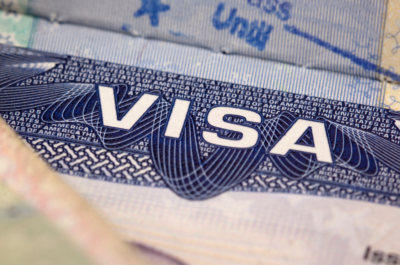
Indonesia and Rwanda sign visa exemption agreement

CAAS and IATA partner to develop global SAF registry

Wyndham opens La Quinta in Auckland, New Zealand

BCEC appoints first sustainability and community engagement advisor

Are solar panel systems suitable for flat metal roof houses?

Vietnam Airlines joins IATA’s CO2 Connect project

Thailand Unveils Groundbreaking “Pink Plus” Economy: A DE&I Game-Changer

Vietnam attends APEC Forum on creative economies in tourism

Adani One partners with Cleartrip for enhanced bus travel in India

Sri Lanka Tourism hosts B2B roadshows in India

Air India announces Bengaluru-London Gatwick non-stop flights

Travel & Tourism in China set to surpass pre-pandemic levels this year

Check In From Anywhere with SITA and SUTD’s New Tech

Trip.com Releases 2024 Trip.Best Global and Asia 100 Lists

“Opportunities in China, Colorful Jilin” Cultural and Tourism Promotion Conference Held in Paris

EPACK Prefab hands-over Phase-II Arrival Area at Darbhanga Airport to AAI

Novotel Hyderabad Convention Centre Introduces EV Charging Station for Sustainable Travel

British Airways Announces New Daily Flight Between Delhi and London Heathrow

Lily Hotels primed to Celebrate Global Wellness Day

G2E Asia and Asian IR Expo in Macao welcome Industry Leaders From Around the World

Spree Hospitality Marks Footprint in Nagpur: Signs Its 9th Property in Maharashtra

AWC Launches “AWC Let’s Pride” Campaign to Celebrate LGBTQ+ Community in Thailand

TTM+ 2024 welcomes global players with “Amazing Thailand: Your Stories Never End” theme

SOTC Travel sees 21% YoY growth in Kolkata market demand

Escape the heatwave: Coolcation is the hot new travel trend

Thailand’s hotels adapt to rising international demand and competitive market

Korean Air launches daily Seoul Incheon-Macau service

Thailand wins Best Adventure Destination in 2024 Leisure Lifestyle Awards

Minor Hotels introduces NH Collection and NH Brands in Sri Lanka
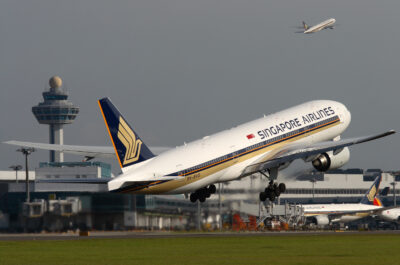
Sabre renews technology agreement with Singapore Airlines

INNSiDE by Meliá Bangkok Sukhumvit welcomes Spanish Chef de Cuisine

Khan Bank and Alipay+ enable cross-border payments in Mongolia


oneworld says “Bula” to Fiji Airways as its 15th full member airline

Air India Express launches 28 weekly flights from Hindon Airport

Bangkok’s Top Restaurants to shine at prestigious TOP25 Restaurants Bangkok Awards 2024

Ben Montgomery elected as PATA Thailand Chapter Chairperson

Asia Pacific travel on the rebound: ForwardKeys expert sees bright future
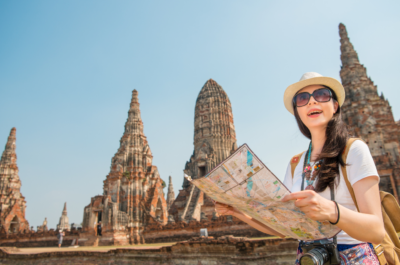
China recovers its position as top spender in 2023 as Asia and the Pacific reopens to tourism

Vietnam’s Ministry of Transport takes action to reduce domestic airfares

The Maldives bans Israeli tourists from entering because of Gaza

Malaysia goes all out to charm Taiwanese tourists at Taipei Tourism Expo

Air India offers check-in and baggage drop at Delhi metro stations

Austrian Airlines increase frequencies between Bangkok to Vienna

A weekend staycation to remember at The Sukhothai Bangkok

ONYX Hospitality Group offers a range of accommodation in Bangkok for Pride month
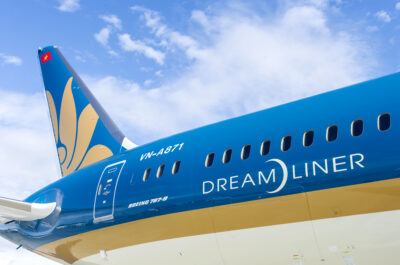
Vietnam Airlines Named Among Top 5 Most Punctual Airlines in Asia Pacific

Sterling Holiday Resorts Arrives in Dehradun, first Spanish Themed hotel

Singapore and Ukraine sign new Air Services Agreement

Philippines and Brunei sign tourism cooperation agreement

COVID-19 impact on hospitality workers’ stress and career trajectories

Lampung Marriott Resort & Spa a New opening in Indonesia
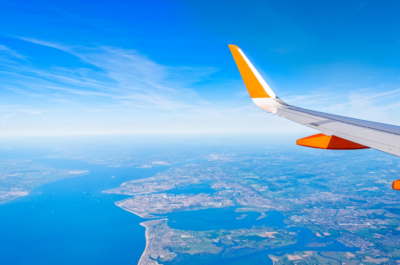
Skyscanner partners with Akasa Air to expand flight options

Park Hyatt Changsha opens in Hunan’s tallest skyscraper

DidaTravel celebrates Disneyland Paris partnership with Shanghai Event

Furama Hotels to debut in Australia with Darling Harbour launch

Pride Hotels signs Pride Elite Haridwar, expands northern presence

Trip Navigator aims for 66% revenue growth in 2024

Hong Kong Airlines launches direct flights to Taichung
- Search Menu
- Sign in through your institution
- Advance articles
- Collections
- Editor's Choice
- Supplements
- Author Guidelines
- Submission Site
- Open Access
- About Journal of Travel Medicine
- About the International Society of Travel Medicine
- Editorial Board
- Advertising and Corporate Services
- Journals Career Network
- Self-Archiving Policy
- Journals on Oxford Academic
- Books on Oxford Academic

Article Contents
Introduction, data availability, authors’ contributions, acknowledgement, funding sources, conflicts of interest.
- < Previous
How Thailand’s tourism industry coped with COVID-19 pandemics: a lesson from the pilot Phuket Tourism Sandbox project
- Article contents
- Figures & tables
- Supplementary Data
Siriluck Thaicharoen, Sukanda Meunrat, Wipawadee Leng-ee, Surachart Koyadun, Nanthasiri Ronnasiri, Sopon Iamsirithaworn, Walairat Chaifoo, Warut Tulalamba, Vip Viprakasit, How Thailand’s tourism industry coped with COVID-19 pandemics: a lesson from the pilot Phuket Tourism Sandbox project, Journal of Travel Medicine , Volume 30, Issue 5, July 2023, taac151, https://doi.org/10.1093/jtm/taac151
- Permissions Icon Permissions
Since the epidemic of coronavirus disease 2019 (COVID-19) caused by severe acute respiratory syndrome coronavirus 2 (SARS-CoV-2) in December 2019, 1 there is an outbreak worldwide. Thailand has started screening for infected individuals who travelled into the country since the beginning of 2020. 2 The Royal Thai government was able to control the outbreak with no report of any local transmission for >200 days. However, the infected cases were found primarily from international inbound travellers and they were quarantined at mandatory state quarantine facilities. 2 , 3 Thereafter, lockdown measures, travel restrictions and COVID-19 risks have battered Thailand’s tourism industry significantly.
Tourism is one of Thailand’s biggest industries, accounting for some 20% of the gross domestic product (GDP). In 2019, Thailand earned 90 billion US$ from domestic and international tourism, but the pandemic caused revenues to crash to 24 billion US$ in 2020. 4 Phuket was ranked the 15 th most-visited place in the world 5 and previously had >10.5 million international tourists creating over 13 billion US$ income, which is close to 90% of the local GDP. 6 In the first 5 months of 2020, Phuket had over 3 million visitors (2 million were foreign visitors) but had only <0.5 million visitors (only ~5000 were foreigners) in 2021. This has impacted both the local and country’s economies and businesses. 7 Therefore, Thailand’s Phuket Tourism ‘Sandbox’ pilot project had been initiated on 1 st July 2021. Previously, all overseas arrivals to Thailand must quarantine for 14 days at an Alternative State Quarantine facilities. However, under the Phuket Sandbox, fully COVID-19 vaccinated travellers from nearly 70 countries were allowed to entry via the Phuket International Airport, and stay at quarantine-free accredited hotels. Regards to Thailand previous experience on COVID-19 travel quarantine exemptions, 8 some policies were also amended. For example, upon arrival, all travellers had to take a RT-PCR test at the airport and waited in their room until a negative result was confirmed (<24 h). Then, travellers could travel within the island of Phuket freely with additional tests during stay. Travellers, who stay in Phuket for 14 days, were able to other areas of Thailand without quarantine.

Demographic data of the travellers entering Phuket under Phuket Tourism Sandbox Program. A total of 38 389 travellers were recorded at the Phuket International Airport with the Certificate of Entry (COE) registered.
This project involved many government officers and more importantly a strong collaboration from local people. This local team known as, Phuket City Development, an organization composing local businessmen and owners of accommodations covered nearly all facilities offered to travellers in Phuket. They played a pivotal role to ensure that the travellers under their service complied with The Phuket Sandbox project’s policies. To monitor and evaluate the risk-benefits of this program; health burden versus the local economy, the Royal Thai Government demanded a comprehensive evaluation and monitoring of this project during the first 3-month pilot to determine the justification for this initiative. As never done before, our analyses were used to evaluate our tourism-opening policy and travel ecosystem leading to the whole national policy of reopening in May 2022. This article will also summarize the impact of the Phuket Tourism Sandbox on the health and economy of Phuket retrieving during the pilot period of this project.
Study setting, population and data analysis
Please see in the Supplementary Method.
Demographic analysis of the travellers
During the first 3 months of this program, a total of 38 389 travellers were recorded to disembark at the Phuket International Airport (HKT) based on the Certificate of Entry (COE). The average of travellers is 417 travellers/day (range 79–913 travellers/day). Since fully vaccinated was required, most of the travellers got Pfizer’s COVID-19 vaccine (53.84%). The most frequent port of origin of travellers (stay at least 21 days prior to travelling) was USA (17.40%). Among travellers, Thai (15.24%) is the highest nationality entering during the project and followed by American (12.36%; Figure 1 and Supplementary Table S1 ).

Positive cases within Phuket during the Sandbox period. (A) SARS-CoV-2-positive cases of the travellers during Sandbox program. (B) SARS-CoV-2-positive cases found in a Phuket and Thailand. (C) SARS-CoV-2-positive cases of travellers by port of origin. (D) Symptomatic of the COVID-19 patients found in Phuket during Sandbox.
Positive cases of travellers and locals within Phuket during the first Sandbox period
According to the Phuket Tourism Sandbox’s regulations, all travellers must get SARS-CoV-2 RT-PCR tests upon arrival (D0) and 2 additional days (D6–7 and D13–14) prior travelling into other areas of Thailand. There were 127 travellers (0.31% of travellers) recorded as COVID-19 positive during the first 3 months (average 1.38 cases/day). The first COVID-19 positive case who arrived at HKT was 0.11% (total 44 cases; average 0.48 cases/day). During the study period, the Delta strain of SARS-CoV-2 was dominant (4.4 days incubation period), we considered that the travellers who got COVID-19 positive results after arrival potentially infected locally within the island. Only 11 travellers were diagnosed with SARS-CoV-2 infection from D0–5 and the rate of positive cases from travellers was likely unchanged throughout the project despite the local infection rate increasing ( Figure 2A ) suggesting that these infected travellers were likely to be in their viral incubation period. There was no correlation between the rate of incoming-infected travellers and the infected locals during suggesting the tourists did not cause any significant COVID-19 spreading to the locals. Most of the travellers (total 72 cases; 59.69%) got COVID-19 positive after D5 which may be a result of the increasing local infection rate ( Figure 2A ). The increasing overall COVID-19-positive rate for local Thais in Phuket was found noticeably about 4 weeks after the increasing rate and peak of SARS-CoV-2 infection at the National level ( Figure 2B ). Using a standard disease control investigation protocol, our study team from the Department of Disease Control found no evidence of viral spreading from overseas infected tourists to our local people. The travellers with the highest percentage of SARS-CoV-2-positive rate were from Myanmar (12.50%) and New Zealand (4.65%) but all of them were also detected after D5 ( Figure 2C ). These results suggested that using the screening policies of the Phuket Tourism Sandbox project, the travellers under the project were well-screened and did not involve the local increase of COVID-19 infection. The travellers with SARS-CoV-2 positive were 67.72% asymptomatic, and only 32.28% have symptoms with only mild severity ( Figure 2D ). Therefore, they did not cause any health economic burden to the local healthcare facility and government hospitals in Phuket.
The economic impact of the Phuket Sandbox initiative
In the beginning, this project was planned for initial 3 months; however, some policies were rapidly adopted during the pilot stage of this project. For example, the tourists under the Sandbox project were allowed to travel to the neighbouring areas such as Samui island, and Phi Phi Island if the RT-PCR at D6–7 were negative. After the evaluation of the 3-months pilot period, the Phuket Sandbox guidelines were adopted nationwide and implemented in other areas such as Krabi, Samui Island, Chiang Mai and Bangkok. For Phuket itself, this program continued from October 2021 onward until May 2022.
During the Phuket Sandbox, the hotel within Phuket was booked for a total of 541 925 pax nights in July–September and 234 932 pax nights in October 2021. The most favourite stays were in Pa Tong beach (40.68%; Figure 3A ). The average stay was 9.94 nights/travellers. The travellers typically spent ~1800 US$/trip. During the first 3 months of the program, >125 million US$ was generated as direct income to Phuket and created almost 300 million US$ as circulating fund for Thailand economics.

The economic impact of The Phuket Sandbox Initiative. (A) Distribution and percentage of the tourist destination by hotel booking. The survey results from the travellers under the Phuket Tourism Sandbox (B) Sandbox Project satisfactory (C) Overall RT-PCR service for SARS-CoV-2 detection on D0, D6–7 and D14. (D) Accommodation service by SHA + Hotel and (E) Overall trip satisfactory in Phuket.
Based on the questionnaires, most travellers (88.33%) satisfied with our Phuket Sandbox project ( Figure 3B ). Some faced some difficulties with the process of COE and documents before entry. For the RT-PCR as well as medical procedures at the airport (D0) and in the city (D7 and D14), >80% of travellers were happy (81.67%) with the services ( Figure 3C ). Similarly, they (95.0%) were gratified with services provided by our health-certified accommodation (SHA + ; Figure 3D ). Finally, 96.7% of travellers had a delightful trip during their stay within Phuket ( Figure 3E ) even during the COVID-19 pandemic. Our study for the first time provided evidence with careful research that monitor the risk and benefits of reopening the tourist industry during the COVID-19 pandemic era. We could find a balance between healthcare risk and possible economic gain that save millions of people from financial downturn. Our data herein were also crucial for our policymakers to adjust and guide the research-driven health policy at the National level. Our success from this Phuket Sandbox program has been widely recognized by the international press 9–11 and several countries with similar tourism destinations followed our lead. 9 , 11 , 12
Based on the current changing world on several grounds including geopolitics, global warming, emerging known and unknown diseases, etc., humankind is now facing more and more unknown disastrous challenges which there is no one absolute guideline or references to follow. Every country is required to adjust and initiate its way of dealing with these challenges under the consideration of different resources and constraints. The recent pandemic has been a great example of such disruptive challenges but not probably the last to tread on humanity at a global scale. To explore the unknown water, a small ‘experimental-like’ or a ‘Sandbox’ approach might be one of the measures to test the policy within a specific area with controllable damages before such policy would be widely adopted. In this regard, a multi-disciplinary approach in the socio-economic evaluation must be included beyond only health and medical aspects to provide a complete 360 degree-picture of any healthcare policy to be implemented. Our Phuket Sandbox program is one of our proofs of this principle.
Finally, the achievement of this program could have not been possible without hard work, determination and tireless cooperation by the local people at Phuket who were instrumental and at the heart of this initiative.
The data has been put in the Supplementary data file of the manuscript.
S.T. and V.V. conceived the original idea and planned the study. S.M., W.L., S.K., N.R., S.I. and W.C. were done the data records, data preparation and primary analysis. W.T. and V.V. wrote the manuscript with support from S.T. All authors discussed the results and contributed to the final manuscript.
The authors would like to thank all staff of the Office of Disease Prevention and Control Region 11 Nakhon Si Thammarat, Ministry of Public Health, and Tourism Authority of Thailand (Phuket office), Ministry of Tourism and Sports for data collection and epidemiological information during the Phuket Tourism Sandbox.
This work was supported by the Office of Disease Prevention and Control Region 11, Department of Disease Control, Ministry of Public Health of Thailand. W.T. and V.V. were supported by the Department of Research, Faculty of Medicine Siriraj Hospital, Mahidol University.
The authors declare no conflict of interest.
Zhou P , Yang XL , Wang XG et al. A pneumonia outbreak associated with a new coronavirus of probable bat origin . Nature 2020 ; 579 : 270 – 3 .
Google Scholar
Triukose S , Nitinawarat S , Satian P et al. Effects of public health interventions on the epidemiological spread during the first wave of the COVID-19 outbreak in Thailand . PLoS One 2021 ; 16 :e0246274.
Chaiwat W , Natcha J , Chayanin S , Charin M . Reconstruction of the transmission dynamics of the first COVID-19 epidemic wave in Thailand . Sci Rep 2021 ; 12 :2002.
Sangiam T. Phuket Sandbox earns 1.6bn baht in tourism revenue . 2021 . https://thainews.prd.go.th/en/news/detail/TCATG210906163716899 ( 6 March 2022, date last accessed) .
Yasmeen R. Top 100 City Destinations: 2019 Edition . 2019 . https://go.euromonitor.com/white-paper-travel-2019-100-cities.html ( 8 March 2022, date last accessed ).
Springer K. Why Phuket's `Sandbox' Pilot Project Matters to Other Islands in Asia . 2021 . https://edition.cnn.com/travel/article/thailand-phuket-sandbox-model-asia-cmd/index.html ( 23 January 2022, date last accessed ).
Koty AC . Thailand’s Sandbox Reopening: Implications for Tourism in Southeast Asia . 2021 https://www.aseanbriefing.com/news/thailands-sandbox-reopening-implications-for-tourism-in-southeast-asia/ (23 January 2022, date last accessed) .
Mungaomklang A , Atsawawaranunt K , Kochakarn T et al. Pitfalls of exceptions for COVID-19 travel quarantine: lessons from a dignitary visit to Thailand . J Travel Med 2021 ; 28 :1–3.
Paddock RC . Thailand’s Quarantine-Island Experiment Is Showing (Modest) Results . The New York Times 2021 . https://www.nytimes.com/2021/10/04/world/asia/thailand-phuket-covid-quarantine.html?smid=url-share (16 October 2022, date last accessed) .
Landy S. Back on the Beach in Thailand's Model `Sandbox '. 2021 . https://asia.nikkei.com/Editor-s-Picks/Tea-Leaves/Back-on-the-beach-in-Thailand-s-model-sandbox (16 October 2022, date last accessed) .
Janssen P. Phuket Sandbox Shines the Way for Thai Tourism Revival . 2021 ; 27/10/2021 : https://asiatimes.com/2021/10/phuket-sandbox-shines-the-way-for-thai-tourism-revival/ (16 October 2022, date last accessed) .
Springer K. Why Phuket's `Sandbox' Pilot Project Matters to Other Islands in Asia . 2021 . https://edition.cnn.com/travel/article/thailand-phuket-sandbox-model-asia-cmd/index.html (16 October 2022, date last accessed) .
Supplementary data
Email alerts, more on this topic, related articles in pubmed, citing articles via.
- Recommend to your Library
Affiliations
- Online ISSN 1708-8305
- Copyright © 2024 International Society of Travel Medicine
- About Oxford Academic
- Publish journals with us
- University press partners
- What we publish
- New features
- Open access
- Institutional account management
- Rights and permissions
- Get help with access
- Accessibility
- Advertising
- Media enquiries
- Oxford University Press
- Oxford Languages
- University of Oxford
Oxford University Press is a department of the University of Oxford. It furthers the University's objective of excellence in research, scholarship, and education by publishing worldwide
- Copyright © 2024 Oxford University Press
- Cookie settings
- Cookie policy
- Privacy policy
- Legal notice
This Feature Is Available To Subscribers Only
Sign In or Create an Account
This PDF is available to Subscribers Only
For full access to this pdf, sign in to an existing account, or purchase an annual subscription.
- Get involved
Community-Based Tourism: Empowering Local Champions for Sustainable Tourism in Thailand
November 6, 2022.

Pattamon Rungchavalnont
Head of Solutions Mapping, Accelerator Lab, Thailand
Thailand is among the world's top tourist destinations. The country’s diverse geographical settings and rich cultural capital provide a vast variety of tourism experiences from relaxing by beautiful sandy beaches of the South to exploring lush green forests of the mountainous North and enjoying local cultures in the Northeast. In 2019, Thailand welcomed a record high of 40 million visitors. For this reason, tourism is a major driver of Thailand’s economic development, providing around 20% of the national GDP and employing over 4.2 million people (11% of total employment). However, Thailand’s tourism industry is not without negative side effects. Unsustainable management of tourism has proven to cause environmental degradation and biodiversity loss as well as fuel uneven economic development. Oftentimes, economic benefits from tourism fall into the hands of large tour operators and investors from the outside while local communities gain minimum economic benefit and are left to suffer many social and environmental drawbacks.
While the COVID-19 pandemic has caused a major setback to the tourism industry, it also provides an opportunity for Thailand to rethink its tourism. Sustainable and resilient tourism has become a key theme for the country and is now one of UNDP Thailand’s focus areas. UNDP Accelerator Lab Thailand seized this opportunity to embark on a journey to support the growing momentum for sustainable tourism by contributing innovative approaches to the redefinition of the country’s tourism industry, specifically from the angle of community-based tourism.
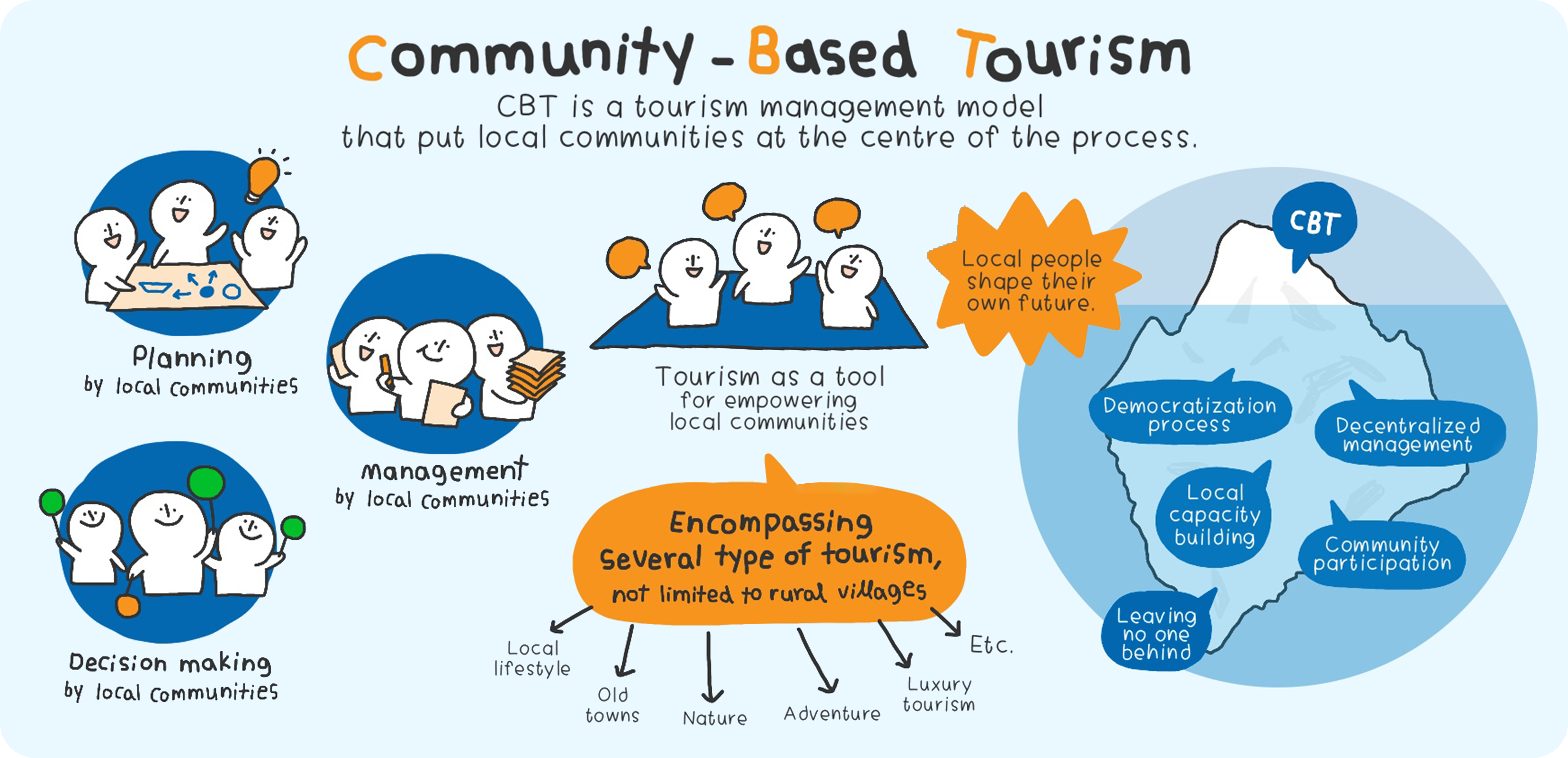
Why community-based tourism?
Emerged in Thailand in the 1990s, ‘community-based tourism (CBT)’ proposes the idea of ‘tourism by the local people for the local people’ . It is one of the solutions for sustainable tourism because, under this framework, local people are the key decision-makers of their tourism development and the ones to fully benefit from it. Being long-term residents of the areas, local communities are more incentivised to balance economic growth and socio-cultural and environmental impacts caused by tourism activities. At the end of the day, it is their home. However, it is crucial to clear the misconception that CBT refers to ‘village tourism,’ limited only to certain styles of tourism that take place in rural areas. CBT is a tourism management model that puts local communities at the center of the process and can encompass diverse tourism styles from rural tourism to urban tourism, nature tourism, or even luxury tourism. Essentially, CBT is about community empowerment as it is a process in which local people are empowered to uplift their own livelihood.
The pandemic has posed both challenges and opportunities for CBT. International travel restrictions caused a major drop in foreign visitors which used to make up a significant portion of visitors for CBT. Local communities needed to adjust themselves to the domestic tourism market and diversify their offers e.g. community products beyond tourism activities. On the other hand, the pandemic has shaped new tourist behaviours- traveling in smaller groups, choosing less crowded destinations, escaping to nature, and searching for unique experiences and activities for well-being, among others. Many of these new preferences match very well with what CBT can offer and can potentially pave way for a golden age of CBT. Moreover, pandemic-induced lockdowns in major cities led to a reverse in rural-urban migration. Many people working in the cities returned to their hometowns during the lockdown and some sought to find livelihood options at home. CBT provides an alternative and in turn benefits from increased human resources- the skilled workforce who have gained skills and exposure from their time working in the cities. All in all, it is an important time for CBT to take the next step to ensure its thrivability in this rapidly changing world.
Making sense of CBT and contemplating on the way forward
As a starting point, national-level workshops were co-organized by UNDP Accelerator Lab Thailand, Thailand Policy Lab, the Designated Areas for Sustainable Tourism Administration (DASTA) , and Local Alike (one of Thailand’s leading social enterprises working on CBT). Representatives from local communities, relevant governmental agencies, the private sector, civil society organizations, and academia exchanged views on trends and weak signals affecting CBT as well as discussed the desirable future and way forward. A few interesting points from the exercise include:
- CBT can go beyond leisure tourism and provide learning experiences for visitors, for example community-based environmental conservation and waste management and tap into opportunities from the rise of corporate social responsibility (CSR) and Thailand’s Bio-Circular-Green (BCG) Economy Model of the government.
- Communities need to build the next generation of CBT leaders. Involvement and incentives for the new generation are key for successful engagement and transition.
- Planning and decision-making should be a bottom-up and collaborative process between the government and local communities to avoid projects which do not fit local contexts or serve the real needs of stakeholders. For instance, many tourism applications were created but abandoned.
- Multisectoral support is crucial for CBT development e.g. support from the private sector on digital transformation, academia on CBT-related curriculum for young leaders, etc.
- Funding mechanisms must be further developed e.g. shifting from an informal arrangement to a social enterprise, setting up CBT development funds, etc.
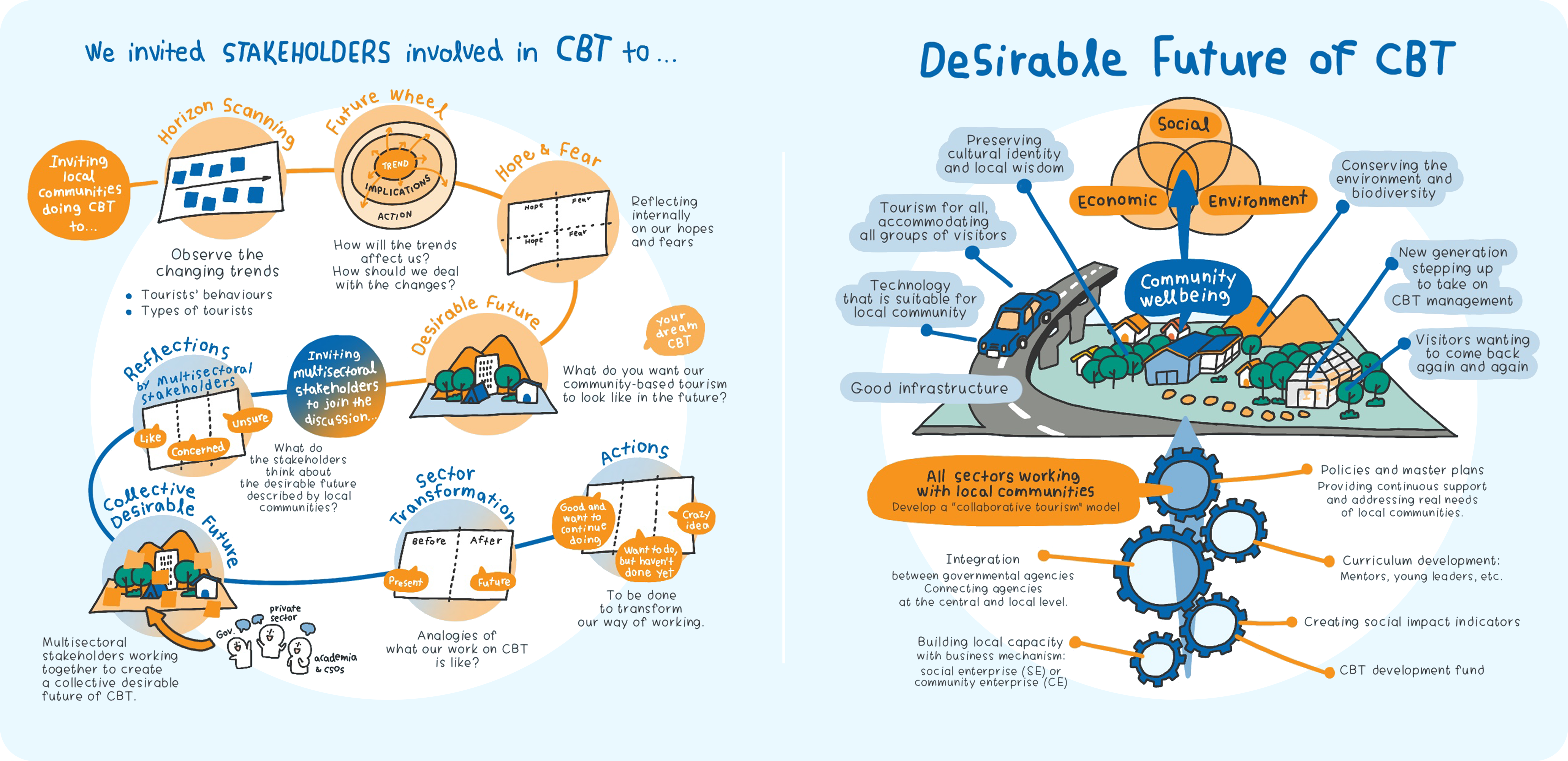
While the discussion revealed multiple areas for development, capacity building for local communities stood out as one of the prerequisites for success. Since local communities are the main drivers of CBT, they must be equipped with frameworks and tools that will enable them to flourish in the rapidly changing world. Existing capacity-building initiatives have been fairly successful in supporting local communities to begin their CBT journey, often focusing on building the foundation and taking a short/medium-term view. While such emphasis is essential, it might not be sufficient any longer. Especially once local communities manage to set up the basics of their CBT, they also need to start thinking about sustainability and being anticipatory. As a result, the Lab identified this as our area of work: how local communities can make their CBT become more sustainable.
Learnings with the locals
UNDP Accelerator Lab Thailand in collaboration with Local Alike joined hands with two pilot communities to start our learning journey. Social innovation tools were applied to invite local stakeholders to reflect on the becoming of their CBT and look forward through the lens of sustainability. Given the different nature of each community, the discussions and sustainability initiatives took on different directions. However, one commonality revealed itself. Community is never homogeneous; CBT development is an area of convergence for different groups to interact and build momentum toward sustainability. To elaborate, let’s take a closer look at each of the pilot communities…
Chulabhorn Pattana 9 community: A case of nature-based tourism from the South
As a neighbour of the world-famous Hala-Bala Wildlife Sanctuary, Chulabhorn Pattana 9 community of Yala province in Southern Thailand has attracted many nature lovers; some visited the village just to enjoy the serenity and beauty of the natural environment while others were excited by the rich biodiversity of the Hala-Bala Forest, not to mention the village’s charming cultural heritage from their Community Malaya time. The village is familiar with receiving visitors as they have been welcoming relatives and friends from Malaysia and Singapore (legacy of Community Malaya time) for decades. Eight years ago, the concept of CBT was introduced, and the new generation stepped up to lead CBT management. The intergenerational difference is reflected in the different views on tourism management- one hoping to increase the number of visitors while another seeking to keep the delicate balance. The new generation realizes that their main target group is nature lovers. Thus, nature is the main capital for their CBT and its conservation is of paramount importance. Hence, the discussion about limiting the number of visitors with consideration of the area’s carrying capacity was very well received by the CBT management team.
CBT at Chulabhorn Pattana 9 does not only aim to mitigate the negative effects of tourism activities but also inspires positive changes in the local community. In many cases, tourism may have resulted in waste management problems. On the contrary, for Chulabhorn Pattana 9 community, the visitors are the ones demanding that waste in the village needs to be better managed. Hearing these comments, the CBT management team was eager to start a waste management initiative with support from the Lab and Local Alike. Waste separation and organic compost-making have been pioneered by the CBT group and will be shared with fellow villagers to inspire more people to join the effort.
In addition, the CBT management team sought to further develop tourism activities that highlight the value of biodiversity and incentivize conservation. Birdwatching was identified as a viable option. Interestingly, apart from our support, birdwatching was born out of collaboration with a visitor who happens to be a bird expert, an ex-member of the Bird Conservation Society of Thailand. Feeling that Chulabhorn Pattana 9 is more than a touristic destination to him, this bird expert saw the potential and was more than willing to help provide training on birdwatching to local guides. Chulabhorn Pattana 9 is able to shift from selling their services to ‘tourists’ to building relationships with ‘visitors’, some of whom have become ‘friends’ to co-create a sustainable future for their CBT.
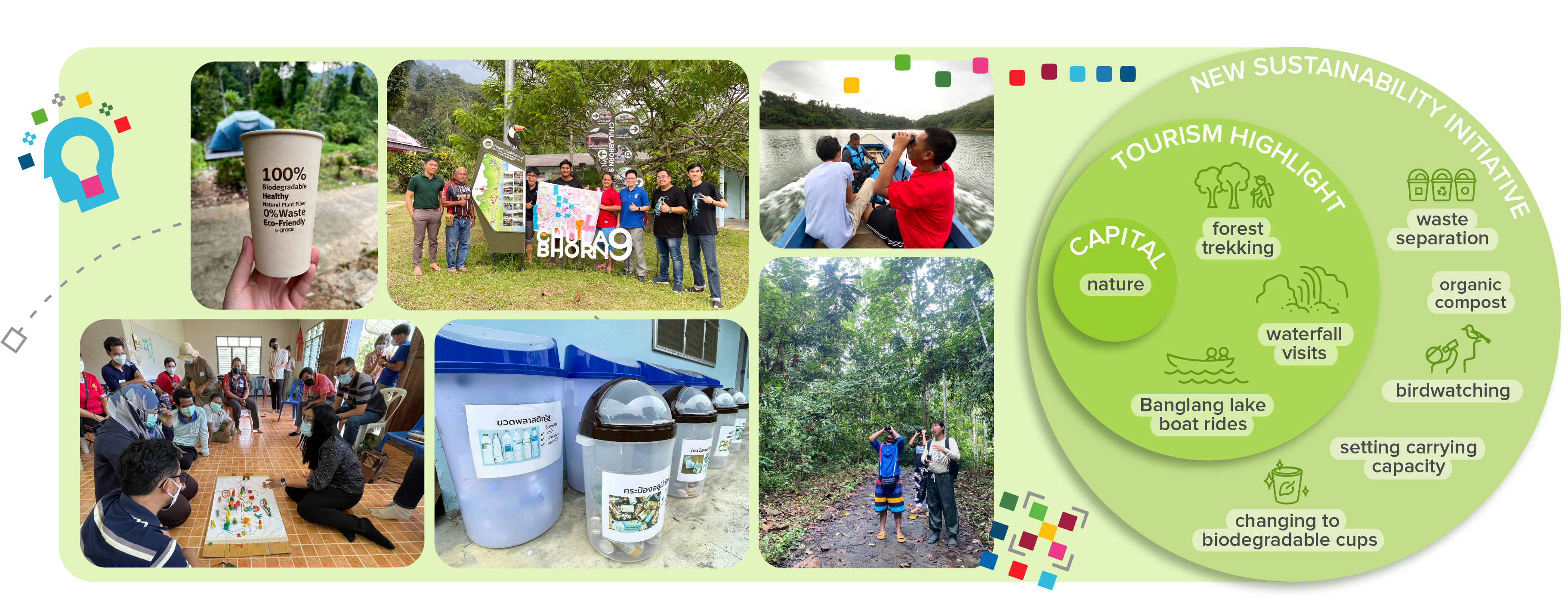
Nong San community: Local life and craft in the Northeast
Nong San community of Sakon Nakhon province in the Northeast of Thailand is famous for its indigo dye handicrafts. Traditional knowledge on indigo dye has been passed on from generation to generation at Nong San village. When combined with the skills of a new generation artist, Pornpimon Mingmitmee, this cultural capital becomes the starting point of Nong San CBT. Visitors, both craft lovers and chillax tourists, enjoy the simple slow life and recharge themselves with natural dye crafts, organic agriculture, and the beauty in the local lifestyle. However, the early days of Nong San CBT were not all easy. The community did not believe that CBT was viable at first, so Pornpimon had to start small and gradually showed other people the success to inspire more support from within the village and nearby community. Furthermore, with the COVID-19-induced lockdown, villagers who used to work in other cities returned to the village and joined force to expand Nong San CBT. However, unlike Chulabhorn Pattana 9 case, Nong San CBT opts for a more decentralized model where each member acts as an independent micro-entrepreneur and loosely connects to provide tour packages for visitors. Therefore, the work here was about business incubation for female micro-entrepreneurs to enhance the distribution of benefits from CBT among the local people. Entrepreneurial skills, including digital marketing, were provided to interested locals.
Circularity is another theme as Pornpimon has been trying to manage waste materials from textile crafts production e.g. left-over threads and fabric scraps. Drawing inspiration from India, the initial idea was to turn textile waste into paper. Local knowledge in Thailand provides a technique for turning natural fibers into handmade paper. Yet, from the prototyping phase, cotton textile waste has proven to be more difficult to handle than other fibers. An alternative was presented as Pornpimon connected with a company working on recycled textiles. The idea is to compile textile waste from the local community, turn it into recycled fabrics, and send it back to the community as raw materials for new products. At the time of writing, the discussion is still ongoing to develop a suitable model of collaboration. This case demonstrates the power of cross-sectoral collaboration in driving CBT toward sustainability.
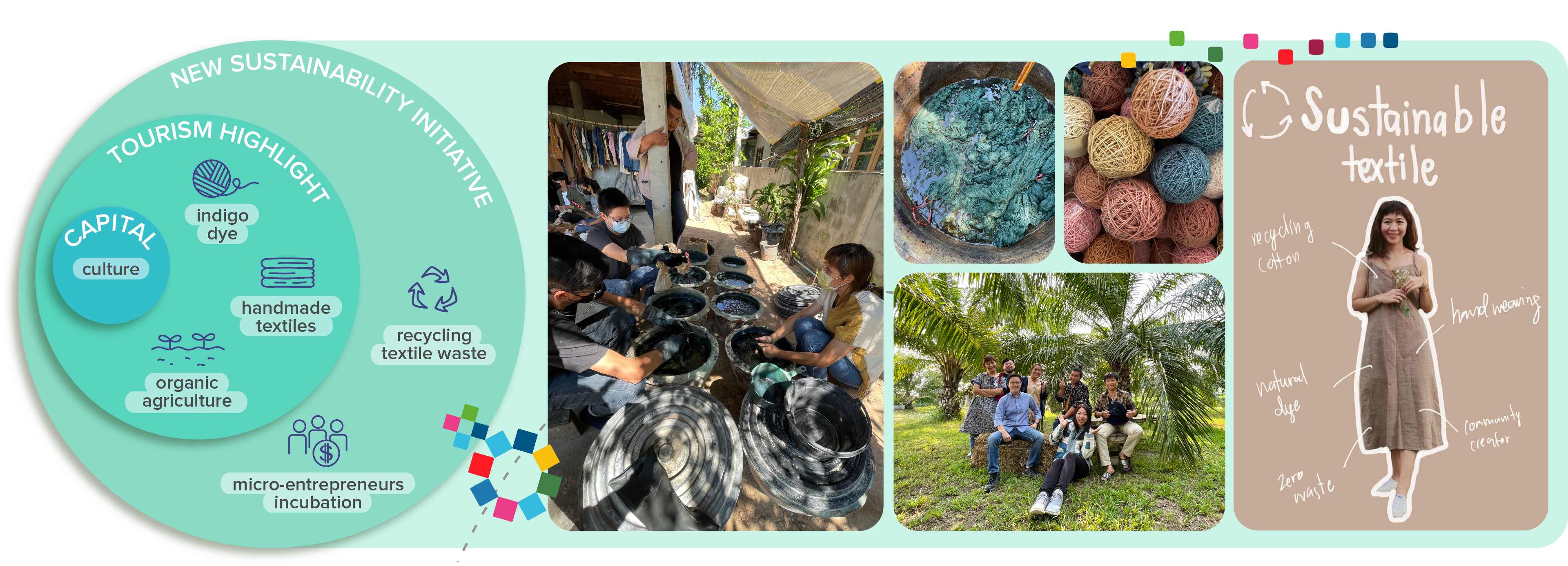
Sharing our experiences
Through the working process with our partners, UNDP Accelerator Lab Thailand was able to learn about CBT development as well as share our social innovation tools with key change agents like Local Alike and relevant governmental agencies. Realizing the value of these tools in facilitating processes towards sustainability and resilience, the Lab together with Local Alike co-produced the Community-Based Tourism Social Innovation Playbook to share with others the experience of Thailand. The Playbook emphasized that social innovation process is not linear. While the tools are categorized into three groups (making sense of the past and present; looking forward to the future; and taking actions), users can always jump back and forth between each category of tools to fill the gaps of knowledge as they surface. Case studies from our work with Chulabhorn Pattana 9 and Nong San communities demonstrate this non-linear journey as well as the fact that no two communities are alike; thus, the social innovation tools must be ultilized in consideration of specific local contexts.
In addition to the publication, the Accelerator Lab Thailand will be working with the Accelerator Lab Bangladesh on CBT development in their context. Follow our next blog to see how Thailand’s experiences can be adapted and what lessons we will learn on the journey to transform tourism into a vehicle for sustainable development.
- Account details
- Lost password
No products in the basket.

- Real Estate
- Media OutReach Newswire
- PR Newswire
- Submit a Press Release

- Press Releases
Overtourism and Challenges for the Thai tourism Industry
Tourism significantly impacts thailand's local economy as one of the main contributors to the annual gdp. however, it is crucial for the country to strike a balance between economic benefits and managing the number of tourists to prevent negative effects of overtourism..

The allure of Thailand’s pristine beaches, cultural richness, and vibrant nightlife has long drawn tourists from around the globe. However, the Thai tourism industry faces a significant challenge: overtourism. This phenomenon, where the number of visitors overwhelms the destination, has led to environmental degradation, cultural dilution, and infrastructure strain, prompting a critical reassessment of tourism practices.
The tourism industry has played a key role in the Thai economy, representing a high portion of the country’s GDP.
Unlimited access to our Premium content
Subscribe to read the entire article.
About the author

Thailand is working towards the Global Minimum Tax Bill
How is thailand fighting global warming.
- Stock Exchange of Thailand releases new plan to attract more foreign firms
- Thailand's Innovative Visa Program attracts 56,000 High Skill foreigners
Related Posts
Bangkok named ‘best city’ in destinasian’s 2024 readers’ choice awards, thailand’s tourism industry drops to 47th place in the world economic forum index, tat and traveloka sign memorandum of agreement to enhance thai tourism promotion, sec imposes civil sanctions on 14 offenders for manipulating the prices (sec news), asean+3 to create a new funding mechanism dedicated to emergency situations.

Thailand ranks as the premier destination in Asia among European travelers
Tourism in thailand just 7% shy of the pre-covid levels.

Latest News

Thailand’s e-commerce market is expected to grow by 13.7% in 2024

Thai government aims to boost economic growth to 3%

Thousands detained as Thailand ramps up cybercrime suppression campaign
What other people are reading.
Subscribe notifications via Email
Enter your email address to subscribe and receive notifications of new posts by email.
Email Address
- Advertising
- Community Standards
- Cookie Policy
- Cryptocurrencies and Digital Asset Laws in Thailand
- Internships
- Investment in Thailand
- Privacy Policy
- Terms of Use
- Thailand Business Visa
© 2023 Thailand Business News
Welcome Back!
Login to your account below
Remember Me
Create New Account!
Fill the forms below to register
Retrieve your password
Please enter your username or email address to reset your password.
Are you sure want to unlock this post?
Are you sure want to cancel subscription.
The pandemic has slowed tourism to Thailand’s Buddhist temples, but the impact is more than economic
Assistant Professor of Religious Studies, Rhodes College
Disclosure statement
Brooke Schedneck does not work for, consult, own shares in or receive funding from any company or organisation that would benefit from this article, and has disclosed no relevant affiliations beyond their academic appointment.
View all partners
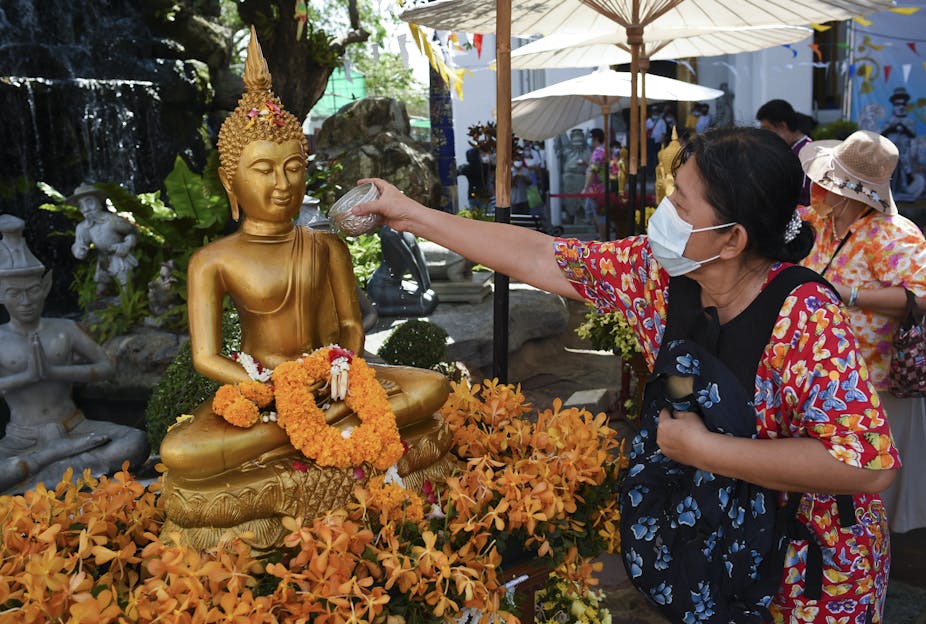
The economies of countries dependent on tourism are clearly hurting, with visitor numbers plummeting as a result of the pandemic.
In Thailand alone, a country where tourism accounts for 11%-12% of the GDP , the number of international tourists dropped by 83% in 2020 . During December 2020 – typically a peak tourism month – the country received just over 6,000 foreign tourists – a 99.8% drop from December 2019 , when there were nearly 4 million foreign tourists.
The Thai government estimates a loss of 100 billion Thai baht (over US$3 billion) in the first quarter of 2020 and a loss of about 1.45 million jobs as a result of this slump in tourism.
However, the actual loss cannot be captured in these numbers alone. Many cross-cultural exchange opportunities have been lost as well.
I spent much of the previous decade living in Chiang Mai, a medium-sized city in northern Thailand, which relies heavily on tourism . As a scholar who was studying the relationship between tourism and Buddhist temples in the region before the pandemic started, I am able to assess the impact of COVID-19 on these sites of religious importance.
Some Buddhist temples that relied heavily on donations from foreign tourists are now struggling to outlast the pandemic . Additionally, small businesses around temples have been badly hurt, as is the knowledge exchange with international visitors.
Temples and tourism
Before the pandemic, Wat Phra Chetuphon, known more commonly as Wat Pho and one of the most-visited temples in Bangkok, would receive about 6,000-10,000 tourists per day . Foreign tourists pay an entry fee of 200 baht, or $6.40, while Thai people enter free of charge.
In an interview in January 2021 with Thai news outlet Prachachat, the assistant abbot of Wat Pho stated that the temple can weather this period without tourists for now, but not for much longer. With donations from Thai people, they were able to pay basic expenses of water and electricity and employ cleaning and security staff. But without the foreign tourist fees, it would become difficult to meet the monthly budget of about $96,000 .

Foreign visitor numbers are also scarce in the most famous temple in Bangkok, Wat Phra Kaew, or the Temple of the Emerald Buddha. This temple is part of the Grand Palace, the Thai royal family’s former residence. In 2016, the Grand Palace was named one of the world’s 50 most-visited tourist attractions in the world by Travel + Leisure magazine, with over 8 million visitors per year.
Typically, the high tourist season would see a long line for entry and crowds of people inside, with foreigners paying $16 for entrance to the temple and the Grand Palace. Again, there is no entrance fee for Thai citizens.
Losses have been significant, for members of the monastic community and small businesses that thrive near these famous temple complexes. Many vendors who sell water, street food and souvenirs around the temple have lost their incomes . Many of these people work within Thailand’s informal economy. A 2018 survey found 55.3% of Thailand’s total population found employment through this informal economy.
Cultural exchange
Much of the the loss of the engagement between foreign tourists and the monastic community cannot be measured in monetary terms. My recent book highlights the energy and effort student monks put into creating programs for foreign tourists to learn about their religion, many aimed at travelers or student groups on college or gap-year programs.
In my research , I have found these cultural exchange programs to be beneficial for tourists and the goals of Buddhist monasticism. Several visitors volunteer while traveling in developing or underdeveloped nations to provide support to those in need. At the same time, these volunteer tourists immerse themselves in different cultures, religions and ways of life.
In Thailand, volunteer tourists typically teach English and could also live in a temple for several months. In my interviews, these tourists said that the experience enabled them to learn about themselves, reflect on their own values and consider new ideas for how to live a happy life .
Buddhist monks see it as their duty to spread their teachings to all who are curious. One program, called Monk Chat , which is hosted by the Buddhist temple Wat Suan Dok and the MahaChulalongkorn Buddhist University, facilitates one-on-one and small-group conversations between monks and foreign travelers in English.

Monks who participate in these programs say that they often develop new ways of thinking based on their discussions with foreigners – from becoming more accepting of cultural differences to being pushed to think deeply about the monastic lifestyle.
For example, when I asked, “How have you changed as a result of meeting foreign tourists?” one monk replied that he used to just accept the monastic rules and practices without considering their purpose. However, after tourists asked why he shaved his head and wore yellow robes, he considered the ways that his lack of hair and uniform were part of a simple lifestyle. He understood more deeply that monks must give up such expressions of individuality as hairstyle and fashion preferences.
Because of the pandemic, Monk Chat has switched to an online outreach. Since April 2020, MonkChat Live is streamed almost every week via Facebook, where various guests, usually monks, prepare some reflections on a specific topic related to Buddhism in the modern world, such as life lessons from COVID-19.
Facebook Live is a good alternative for now, but it does not have the same impact as talking directly with foreigners. The format is more formal, with little chance for personal sharing or observing the playful ways monks interact with one another.
It is difficult to measure these losses, but undoubtedly they will leave a deep impact for some time to come.
- Informal economy
- Buddhist Temples
- Buddhist teachings

Research Process Engineer

Laboratory Head - RNA Biology

Head of School, School of Arts & Social Sciences, Monash University Malaysia

Chief Operating Officer (COO)

Data Manager

Sustainable Tourism in Thailand – Ecotourism, Wildlife and Culture Guide
- Last Updated: January 19, 2024
Thailand, the Land of Smiles, has firmly cemented itself as one of the most popular tourist destinations on the planet.
With 39 million people visiting the Southeast Asian nation in 2019 , the word is well and truly out on just how magical Thailand really is.
The international tourism industry in Thailand really started back in the 1970s, when travellers made their way here along the old ‘Hippie Trail’ from England.
This paradise was their reward after months of tough overlanding, with swaying palm trees, white-sand beaches, hospitable locals, and some of the tastiest food imaginable.
Today the magic is still alive and well in Thailand, and with so many incredible places to visit , it’s the kind of place you can visit again and again and always discover something new.
Locals welcome tourists with open arms, excited to show their local culture and customs to visitors and to improve their own livelihoods through businesses that cater to international travellers.
The impacts of the tourism industry on Thailand haven’t always been positive though, and with the growing number of people coming every year, there has been a number of issues arise.
As a responsible traveller , it’s important for us all to do our part to protect the countries we visit, including the environment, culture, local community, and wildlife.
READ MORE: Don’t miss our comprehensive guide to sustainable tourism .
Table of Contents
Closing Popular Tourist Destinations
‘no foam no plastic’, new heaven reef conservation, elephant nature park, the soi dog foundation, the gibbon project, phuket, bangkok tree house, soneva kiri – koh kood, rabeang pasak treehouse resort – chiang mai, always show respect to the king, do not turn your back towards buddha, watch where you point your feet, do not touch a person’s head, show respect to the monks, dress modestly, cover-up in temples, do not raise your voice, try to learn a few thai words, barter, but don’t be extreme, long-neck tribes, minimise your plastic use, do not litter, take public transport where possible, oceans and marine parks, travel off the beaten path, local community based tourism in thailand, sustainable tourism in thailand – the ultimate guide.
We’ve been fortunate enough to spend almost an entire year travelling and living in Thailand, and it is honestly one of our favourite countries in the world.
As part of our travels we’ve seen the best, and worst, of tourist behaviour and impacts here, which is why we have published this guide.
We are big advocates for sustainable tourism, and we are pleased to see it’s not just a global trend, but a movement that even the Thai government is taking very seriously.
Before you decide to travel to the Land of Smiles, make sure you read up on these tips and ideas on how to travel to Thailand responsibly.
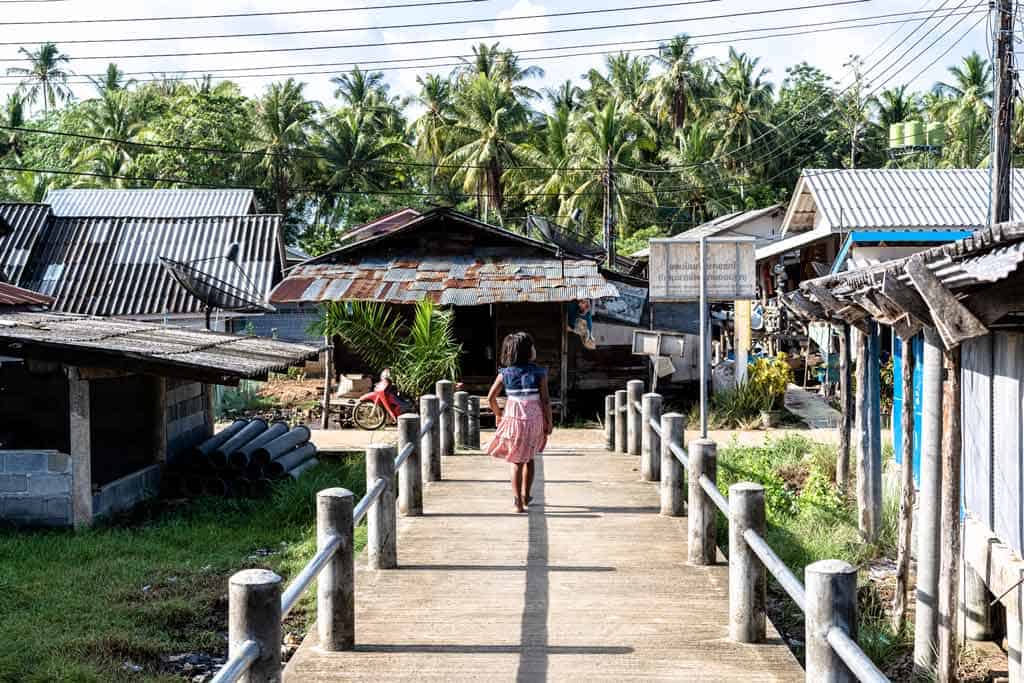
The Thai Government’s Own Initiatives
In recent years, the Thai government has seen the impacts of the tourism industry, both positive and negative, and has taken a firm stance to improve sustainability throughout the Kingdom.
It’s uplifting to see a government take what may seem like drastic measures to protect their own environment and local culture, and they have become an example to other Asian nations on how sustainable tourism can really be beneficial.
To read more about this, be sure to check out their dedicated website, 7 Greens .
Here are some examples of what they have done in recent years.
Every year the Department of National Parks, Wildlife and Plant Conservation takes extreme measures to protect the most heavily-visited regions of the country by closing them to tourists.
The biggest example of this when Thailand closed Maya Bay, the island close to Koh Phi Phi , which was made famous when featured in the movie The Beach.
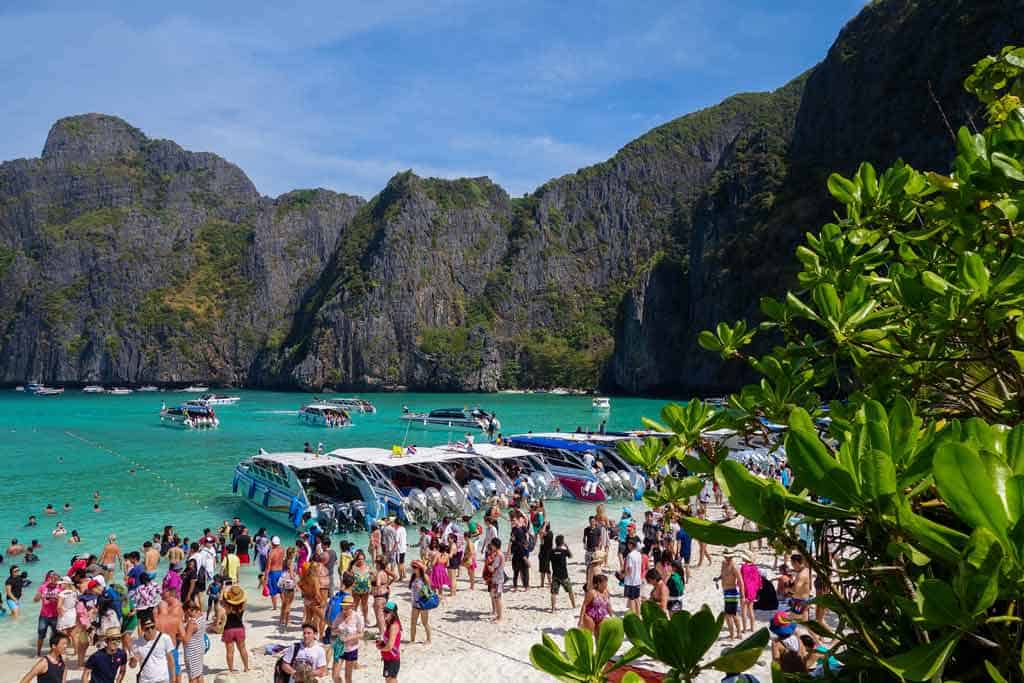
Over the years Maya Bay became a victim of its own beauty, with millions of tourists flocking into the narrow cove.
The huge numbers of people resulted in severe damage to the ecosystem, with marine life disappearing, waters becoming polluted and trash piling up.
The government closed access to the island in June 2018, citing the need for it to recover.
They are doing similar things to other popular destinations, often during the rainy season when the environment is at its most fragile, and are seeing excellent results.
On some of the most popular beaches in Thailand, the government has completely banned smoking.
They saw the damage cigarettes were doing, with tourists and locals leaving their butts on the ground, and the smoke causing health issues, and decided to remove the problem completely.
This ban is in effect in Phuket, Phang-nga, Krabi, Trang, Samui, Hua Hin, Cha-am, Chon Buri, Rayong and Trat.
The other big initiative that the Thai government and local businesses have introduced as of August 2018 is banning single-use plastics from all 154 national and regional parks around the country.
And in 2020 Thailand took it a step further by banning single-use plastic bags, with an aim to have these completely eradicated from all stores by 2021.
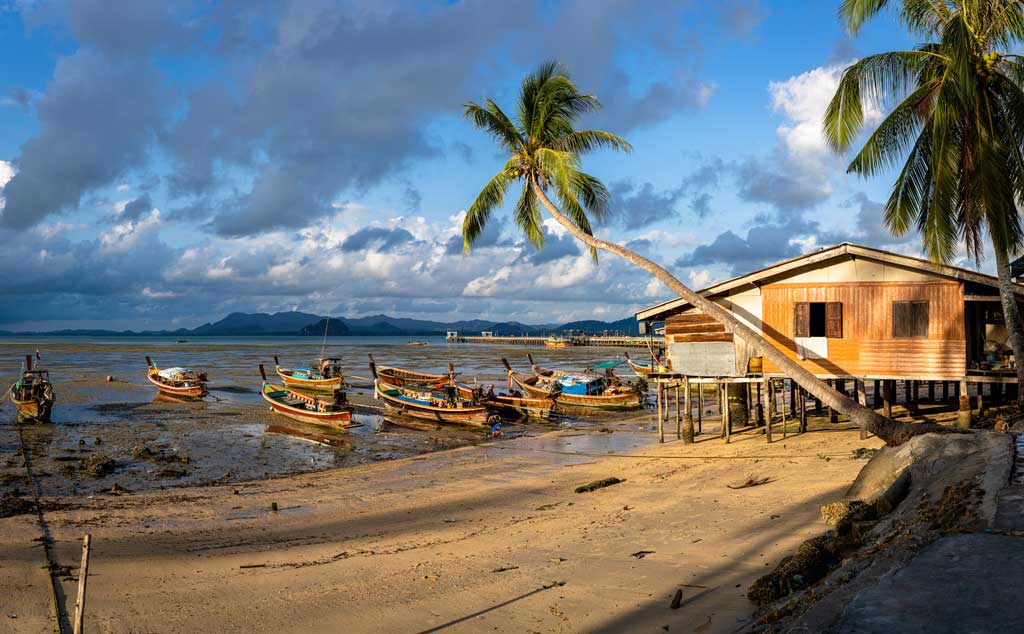
Ecotourism in Thailand
What is ecotourism? It is defined as: “tourism directed towards exotic, often threatened, natural environments, intended to support conservation efforts and observe wildlife.”
The concept of ecotourism in Thailand isn’t new, but it was always more of a niche offering compared to the typical resort-style travel that many visitors would do.
Today it is a different story though, and more and more businesses are incorporating ecotourism practices into their products.
You can find a variety of conservation projects in Thailand, focused on sustainable travel and environment and wildlife protection.
Environment Conservation Projects
Here are some of our favourite conservation projects focusing on sustainable travel and the environment:
Based on the spectacular island of Koh Tao, the New Heaven Reef Conservation , this organisation runs marine-specific courses and projects to protect and study the underwater world in the Gulf of Thailand.
Trash Hero is an initiative that has gone global but was started right in Bangkok.
According to their website, “TRASH HERO is an energetic, volunteer-led movement that drives change within communities around the world, motivating and supporting them to clean and prevent plastic waste.”
So next time you’re in Bangkok, get in touch with them and join the crew for a waste clean-up.
Wildlife Conservation Projects
We’ll go into the wildlife activities further below in the article, but there are some excellent wildlife conservation projects that you can support when practicing sustainable travel in Thailand.
By far the best elephant sanctuary and conservation project in Thailand, Elephant Nature Park has been committed to protecting elephants since 1998.
Founded in Chiang Mai by the incredible Thai lady, Lek, ENP now has a number of projects around the country, as well as in Cambodia and soon Myanmar.
You can visit Elephant Nature Park for a day, or even volunteer for up to a month.
The Soi Dog Foundation has made it their mission to protect the thousands of stray dogs that are found all over Thailand and to end the dog meat trade in Southeast Asia.
You can help out by donating to their cause, or volunteering when in Bangkok or Phuket.
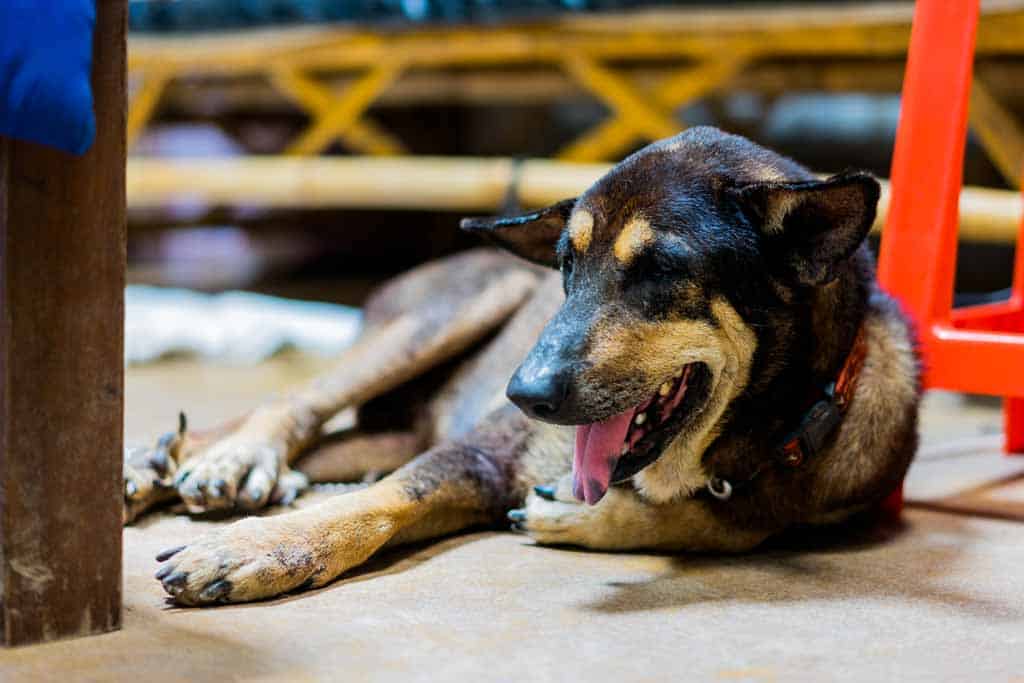
The Gibbon Project is a fantastic conservation initiative that can be found in the popular resort town of Phuket.
The project rescues and rehabilitates these gorgeous, yet endangered, monkeys and then reintroduces them into protected natural habitats.
You can visit their facility in Phuket if you book ahead.
Wildlife Activities
Thailand is home to several impressive wildlife species, which many tourists naturally want to see when they travel to the country.
In general, the best way to stay responsible when it comes to travelling in Thailand is to not take part in any activity that exploits wildlife.
Perhaps the main animal people would like to see in Thailand is an elephant.
These beautiful, intelligent, and enormous creatures live deep in the jungles of Thailand and have been a part of local culture for centuries.
But did you know there is an estimated 3800 captive elephants in Thailand, with perhaps less than 1000 in the wild ?
One popular activity is to ride an elephant in Thailand, however, this is actually a very irresponsible thing to do for several reasons.
- An elephant, while very strong, has not evolved to carry weight on its back.
- The process of ‘breaking’ an elephant in order for it to be safe around tourists is extremely distressing.
- Elephants used for riding are often overworked and malnourished in order to maximise their profit margin.
It is extremely important that you never ride an elephant, no matter how much you think it would be ‘fun’ or ‘cool’, and never visit an elephant show where they are forced to perform tricks.
Instead, it is much more wholesome to visit a reputable elephant sanctuary where the animals have been rescued and placed in a protected natural environment to live out their lives the way they were meant to.
Spending time around an elephant is an experience you will never forget, and is something you absolutely should do while visiting Thailand, but please do so in an ethical and responsible way.
We highly recommend the following sanctuaries:
- Elephant Nature Park in Chiang Mai
- Surin Project in Surin
- Elephant Haven in Kanchanaburi
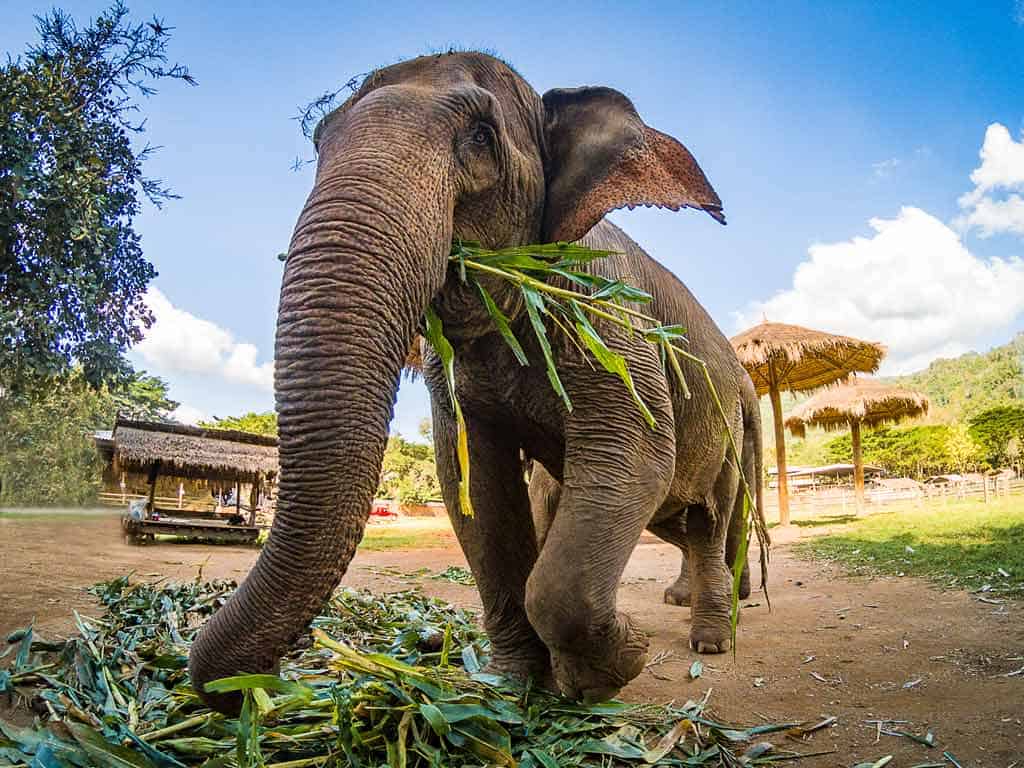
Another popular attraction for first-time visitors to Thailand are the ‘Tiger Temples’ that offer the chance to get up close and personal with a tiger.
As tempting as it is to get your selfie with a tiger, the truth is that what happens behind the scenes at these places doesn’t always have the tigers’ best interests at heart.
A tiger sanctuary in Kanchanaburi was raided in 2016 due to suspected trafficking and illegal breeding, and the Thai government ultimately seized all the animals that were on the property.
So where can you see a tiger in Thailand?
The World Wildlife Fund estimated that there are only 189 tigers in the wild , so unfortunately the chance of seeing one in the wild is very slim.
It’s not all bad news though. Tigers have recently been caught on tracking cameras in the far north of the country, showing that they are starting to make a comeback thanks to the Thai government’s restrictions on poaching and illegal logging.
There are currently no ethical tiger sanctuaries in Thailand.
There are five different types of monkeys in Thailand, and you will find them everywhere.
If you head to the south of the country they are extremely prominent around the islands, especially in places like Krabi.
Seeing them is always quite exciting, however, just like elephants, many macaques in Thailand have been captured and forced to perform tricks and shows for tourists.
Don’t support these shows, and instead hope to see some monkeys in the wild.
READ MORE: Be sure to read our comprehensive guide to travelling Thailand here .
Eco-friendly Accommodation in Thailand
Thailand has every style of accommodation you could ever imagine, from world-class 5-star resorts to basic bamboo shacks.
When it comes to choosing the level of luxury you want, the limit really is only your wallet.
However, on an eco level, the 5-star resort might be worse than the bamboo shack when it comes to looking after the environment.
This can be for a number of reasons, whether it is due to overtourism, large resorts not being able to control their environmental footprint properly, or putting an emphasis on profits.
And the larger the resort, the larger the impact. That’s why it’s important to look for eco-friendly accommodation when you practice sustainable travel in Thailand.
So what makes a hotel or guesthouse eco-friendly?
We wrote a dedicated post on how to choose sustainable accommodation here , but let us give the main pointers again.
This is what a hotel can do to try and focus more on sustainable travel:
- Limiting energy consumption
- Limiting water consumption
- Reducing waste production
- Using renewable energy
- Promoting environmental education
- Contributing profits to green charities
- Using recycled and locally-sourced products
It seems pretty straightforward, and in all likelihood, you’re probably doing a lot of these things in your own home as well.
But when it comes to the hotel industry, it’s easy to do what is known as ‘greenwashing’, where they claim to be eco-friendly by doing a few things like telling guests to watch their water use, but then don’t do anything else on their end.
We recommend you give the article above a good read to get a better idea of this, but for now let us showcase some of the best eco-friendly hotels in Thailand.
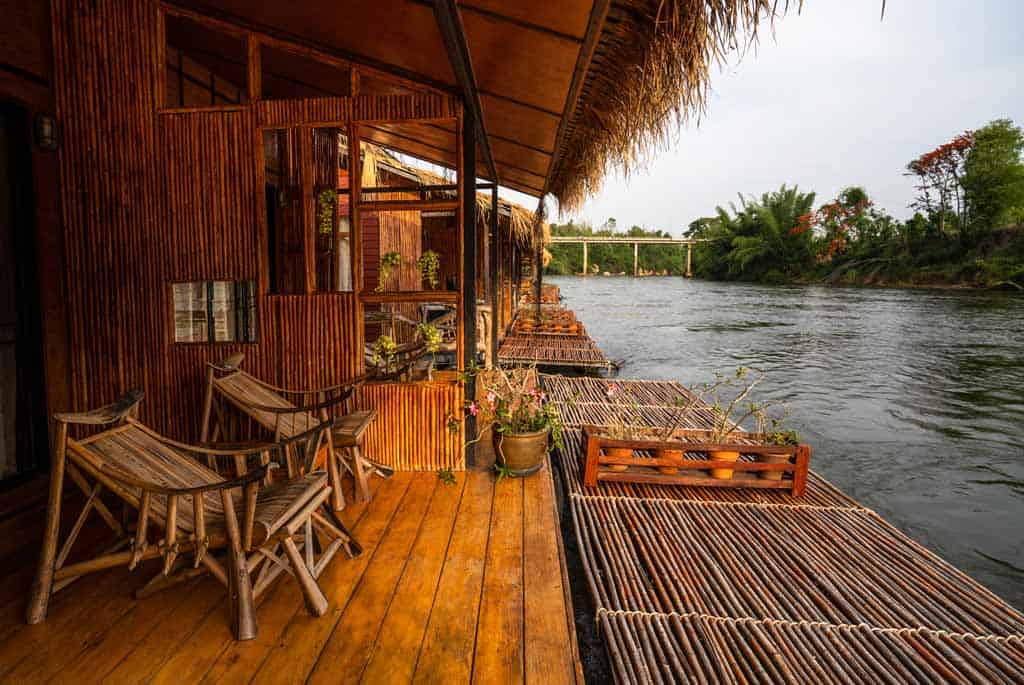
Located in a literal jungle deep in the urban jungle of Bangkok, the Bangkok Tree House is one example of an accommodation that is not only doing their part to protect the environment, but also providing a unique experience for their guests.
Their ‘nests’ live high in the canopy, and you’re sure to fall in love with what they have built.
Bangkok Tree House is also fully committed to being green, and they’ve minimised their carbon footprint in every way possible.
They also use vertical gardens to grow their food and vegetables, and recycle or reuse all of their materials.
The island of Koh Kood is the go-to destination for lovers of luxury, and the swaying palm trees over powder sand beaches is a real drawcard.
If you do visit, we recommend staying at the number 1 eco-resort on the island – Soneva Kiri .
This is the one place where you can splurge out for an unparalleled experience (each villa comes with private infinity pools and a personal butler), knowing that your money is supporting community-based tourism and protecting the environment.
Soneva Kiri puts their profits towards coral restoration projects and supporting local communities, raising close to $6 million for people in need.
They are also completely carbon neutural and a pillar of sustainable travel.
If you’re travelling on a budget but still want to do what you can to support sustainable travel and ecotourism in Thailand, it’s worth checking out Rabeang Pasak Treehouse Resort in Chiang Mai.
The property is made up of sustainably-built treehouses just outside of the city, set in a stunning forest landscape with a focus on minimising their footprint.
The eco friendly facilities are basic, but you’ll fall in love with the simple way of living surrounded by the sound of nature.
Culture and Customs – Respecting the Locals
You may feel that sustainable tourism is all about protecting the environment and wildlife, but there is another element that needs to be considered – the human element.
One of the big rewards of travelling the world is having the chance to learn about new cultures, and in Thailand, the culture is one of the most fascinating you can encounter.
The predominantly-Buddhist nation is built on the ethos of kindness, hospitality and respect, and as soon as you touch down here for the first time you’ll know exactly what we mean.
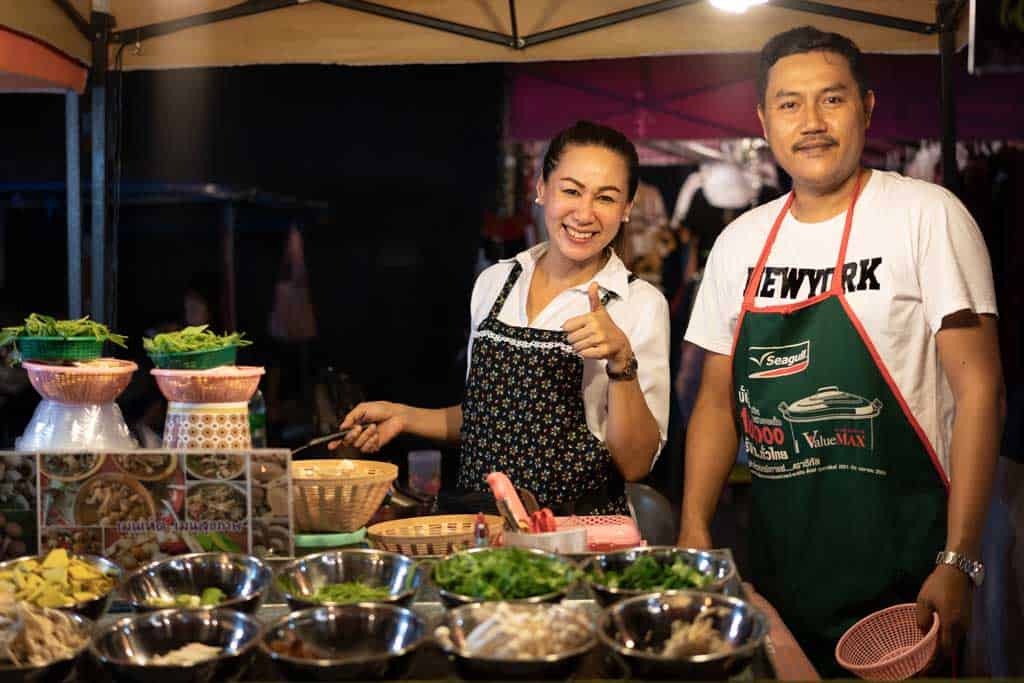
People bow (known as wai) to greet to each other with a warm “Sa wa dee”, and they finish each sentence with “ka” or “krup”, depending on whether they’re addressing a male or female, as a sign of courtesy and respect.
A visit to a Buddhist temple also gives a unique insight into the beliefs of the Thai people, and one of the best things you can do is simply sit and watch as they pray and make their offerings to get a better understanding into what Buddhism is about.
It’s important to open your heart and mind to these local customs when you travel to Thailand.
Things may be different to what you’re used to at home, but isn’t that the joy of travelling?
There are a number of unique customs that Thai people have that you should keep in mind and respect when visiting the country.
Here’s a breakdown of the most important ones.
The King of Thailand is the most revered person in the country, and Thai people love him dearly.
Do not show any disrespect towards him or the Royal Family (in fact it is against the law to do so) by talking negatively about them.
Anything with their likeness on it is also considered important, such as the local money that has the King’s portrait printed on it, so be careful not to cause any damage to this.
As an example, if you drop a note, do not step on it with your feet to stop it from blowing away, as this is considered disrespectful. Instead, pick it up with your hand.
When visiting a Buddhist temple, always face the Buddha and don’t turn your back towards him.
The proper way to exit a temple is to walk backwards to the door, turn at the last minute.
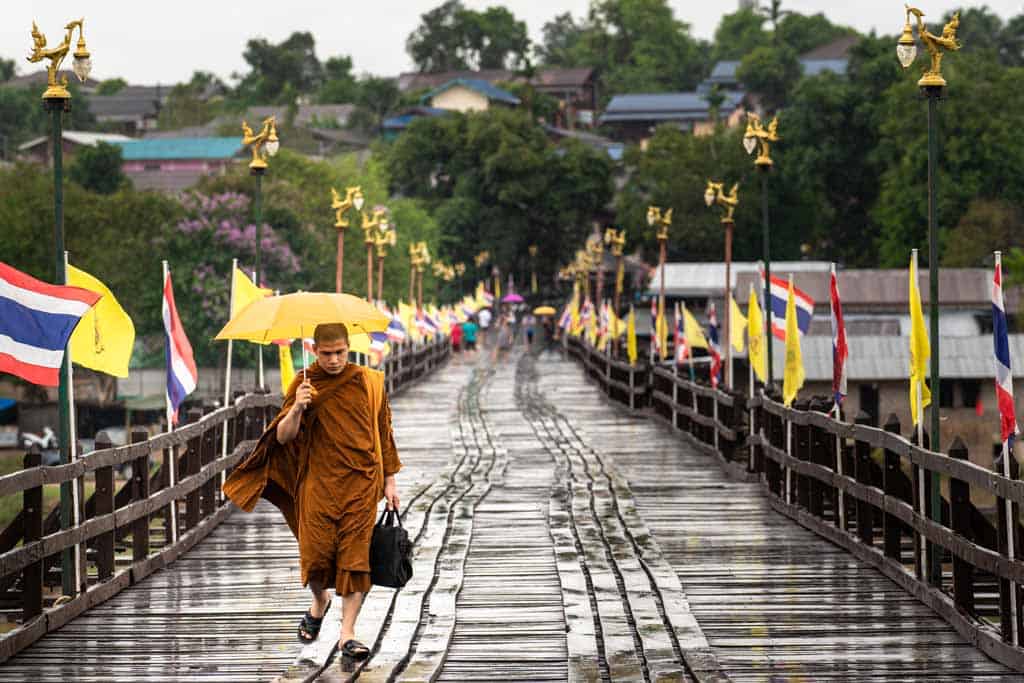
The feet, being the lowest part of the body, are considered to be dirty, and as such make sure you never point your feet towards somebody on purpose.
That is why Thais tend to sit on their feet or cross their legs, rather than sitting with their feet spread out in front of them – to make sure they don’t point them at another person, or Buddha.
The opposite of the feet, a person’s head is considered to be the most important part of the body, and it is disrespectful to touch somebody’s head.
When you see a Buddhist monk, whether it’s in a temple or out in public, always show respect to them.
Ways you can do this are to bow when they walk past, try to keep your head level below theirs (remember, it’s the most important part of the body), and giving up your seat for them.
Thai people are very modest and can be somewhat conservative. So you should make sure you always dress appropriately.
As an example, when you’re at the beach it’s ok to wear swimwear, but when you leave the beach make sure you cover up.
Do not wear a bikini or no shirt into a store or restaurant, and don’t walk around town showing excess skin, as this may make some locals feel uncomfortable.
As a good rule of thumb, look around at what the locals are wearing. If they’re not in a bikini, you shouldn’t be either, no matter how hot it is.
As an extension of dressing modestly, if you are entering a temple, make sure you wear appropriate clothing.
This includes covering your shoulders (ladies can usually get a sarong at the door to do so).
Thai people hate confrontation and raising your voice and yelling is one of the most disrespectful things you can do.
Even if you’re feeling frustrated at a lack of communication, or feel as though you may be getting taken advantage of in a transaction, keep your cool and speak in a normal tone.
You will achieve nothing by screaming at somebody, and you will lose all respect.
Always be polite, and the locals will be the same to you.
The Thai language is notoriously difficult to learn for English-speakers, and nobody expects you to become fluent in Thai during a holiday.
But locals will be very appreciative if you at least put a little bit of effort into speaking their own tongue.
Just pick up the basics, such as hello, thank you, how much, goodbye, and perhaps try to count to 10.
If you are shopping for souvenirs in a market, it’s normal to barter, but don’t go over the top and try to negotiate an extremely cheap price.
You might think it’s a game, but remember that the locals need to make a living too, and a few dollars here and there will help them out a lot more than it will you.
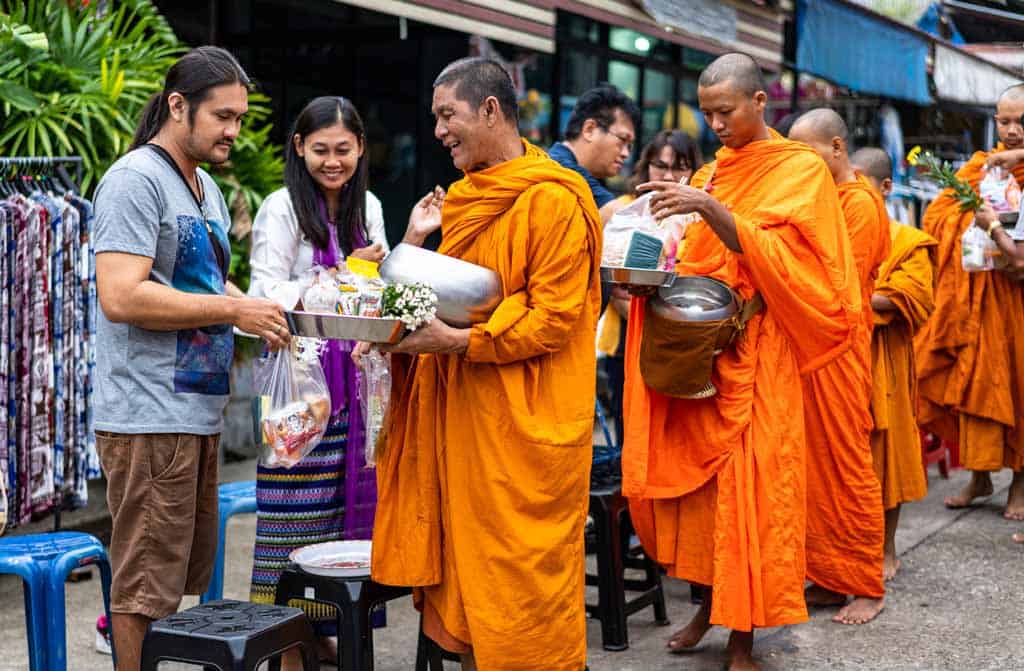
Unethical Attractions Involving People
On an ethical level, there are a number of tourist activities and attractions that exploit the wonderful local people of Thailand.
As a general rule of thumb, be very cautious about joining any cheap tour that involves a visit to a minority tribe, involves children, and sexual exploitation attractions such as the infamous Ping Pong Shows of Phuket and Bangkok.
These are some of the most important ones to avoid.
In the north of Thailand, the famous long-neck tribes from the Karen and Kayan ethnic minority communities have been a unique example of where a tradition has been exploited for tourist reasons.
Many travellers want to come to these remote villages to see the practice of women putting rings around their necks to elongate them.
But what few people realise is that this tradition causes extreme health problems.
In fact, many of these communities have expressed a desire to stop putting themselves through such a problematic modification of their bodies, but there is one reason to continue it – tourist dollars.
If it wasn’t for international tourists spending money to visit their tribes, they would stop the practice and return to their normal lives.
Another issue is that most of the money from these hill tribe tours don’t actually go to the local communities. Instead they are kept by the operators, and the villages make their money by trying to sell handicrafts.
Over the years the concept of ‘voluntourism’ has become popular for many visitors who wish to give back to the communities they are visiting.
While this is a noble idea, and for the most part people’s hearts are in the right place, there are issues with this type of tourism.
The biggest concern is when it comes to visiting orphanages.
Unfortunately there are several children who have been orphaned in Thailand, and it’s only normal to want to help them.
But unless you have experience with child care in these exact environments and are planning to stay for a long time, a day trip to an orphanage isn’t the best way to do this.
Instead the best way to help is to donate money and supplies through reputable charities.
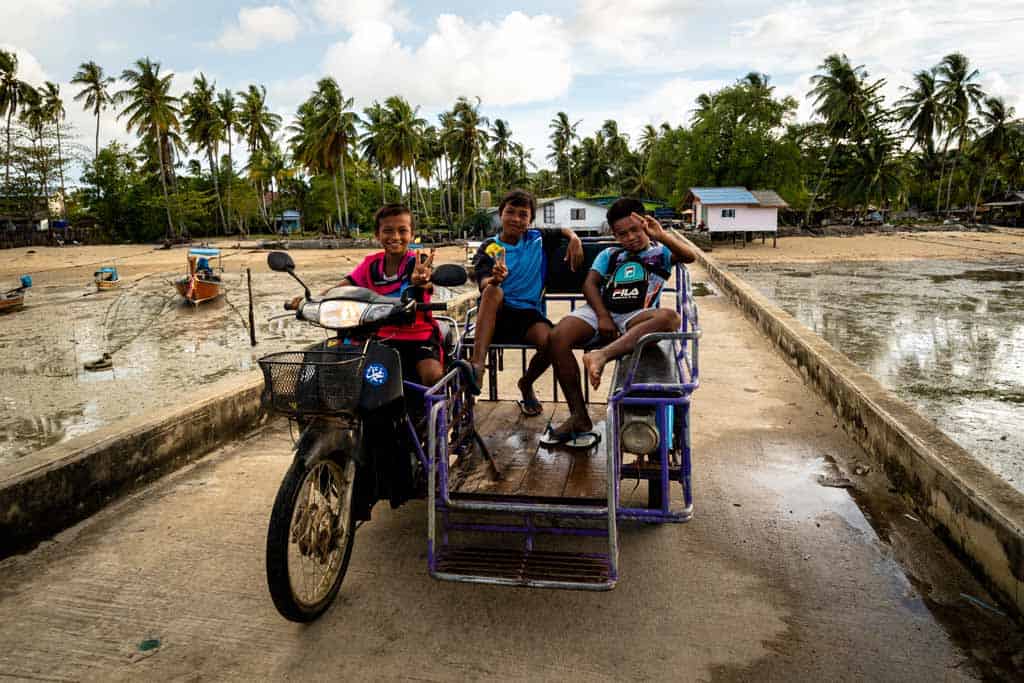
Protecting the Environment
Thailand really is one of the most beautiful countries in the world, and it has almost every type of landscape you could wish for.
When you decide to visit, it’s important to minimise your footprint and protect this spectacular environment.
Here are the best ways to do just that.
While Thailand is taking steps to remove all single-use plastics by 2021, you can do your part as well by bringing your own reusable items.
Make sure you add these to your Thailand packing list :
- A reusable water bottle. Not only can you usually refill these from large jugs at your accommodation, Thailand also has reverse osmosis machines on almost every city block so you can get drinking water for as low as 1THB per litre.
- A carry bag. Don’t take a plastic bag when you shop, and instead bring your own cloth one.
- Metal cutlery. You’ll most likely be eating a lot of delicious food on your trip, but don’t just always grab the plastic cutlery available. Throw your own in your bag and save on waste.
This one is pretty self-explanatory, but you’d be amazed at how many tourists we’ve personally seen throw their rubbish on the ground or off the side of a boat.
Under no circumstance should you ditch your rubbish anywhere but in a bin.
No matter how much of an inconvenience it is to carry until you find one, do not contribute to polluting the earth by being careless.
Carbon emissions from airplanes and vehicles are quite high around the world, but you can minimise your own carbon footprint in a few different ways.
First of all, don’t take any more flights than you absolutely have to. For example, rather than flying from Bangkok to Chiang Mai, why not take the train?
Second, always go for public transport where possible. Take a public ferry or songthaew instead of renting a private boat or car.
Third, and even better for the environment, walk or rent a bicycle to get around.
Take extra care when spending time in the stunning Andaman Sea and Gulf of Thailand.
Plastic and trash often end up in the oceans, killing marine life and polluting the sea for future generations.
Also try to avoid any overcrowding of popular destinations. The last thing we need is another Maya Bay catastrophe.
Another way you can protect the oceans is to never touch sea life or coral.
This includes standing on reefs when snorkelling or swimming, and not collecting souvenirs from the sea.
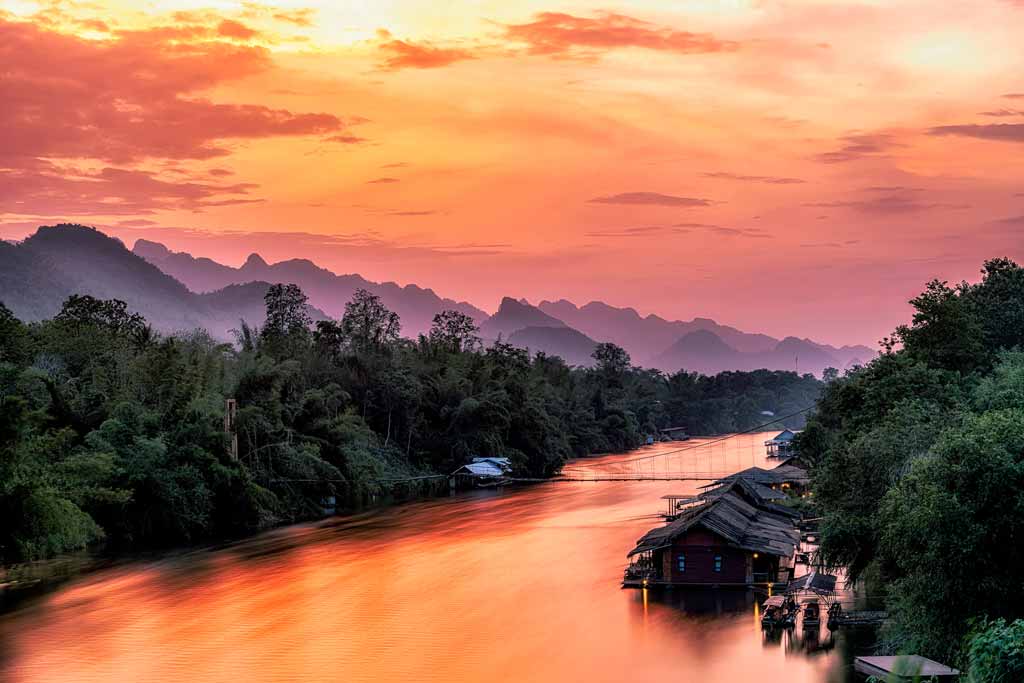
Avoiding Overtourism
Overtourism is when the amount of visitors a place receives reaches a level that is no longer sustainable from an environmental or societal viewpoint.
We’ve dived deeper into overtourism and ways you can combat this in this detailed guide , but we’d like to give some ideas here on how this applies specifically to Thailand. These tricks will help you navigate the tourism industry in a responsible way.
Rather than spending all your time in the most popular destinations in Thailand, consider visiting places that fewer tourists get to.
For example, Chiang Mai is absolutely incredible and definitely deserves a few days to explore, but when you’re finished here you can visit the lesser-visited Mae Hong Son.
Down in the south get out of Phuket and check out Trang or Koh Mook instead.
The benefits of getting off the beaten path is that you’ll have the chance to spend time in places that not as many international tourists see, and you’ll spread your tourist dollar to communities that really need it.
Finally in our sustainable tourism in Thailand guide, we will touch on the concept of local community based tourism.
Local community based tourism is where a visitor spends time in a local village and spends their money directly with vendors and small businesses rather than big operators or companies. Putting your energy and money into community based tourism rather than the big tourism industry is a great way to support the locals.
This simple mindset and action when travelling can have tremendous benefits for a local community and economy, and in a country like Thailand it is very easy to do.
Just like getting off the beaten path, we recommend you visit places that don’t see as many tourists and booking accommodation and activities directly with businesses.
You can spend the night in local guesthouses or eat at local restaurants to help inject your money directly into the local communities. There are many ways to try local community based tourism!
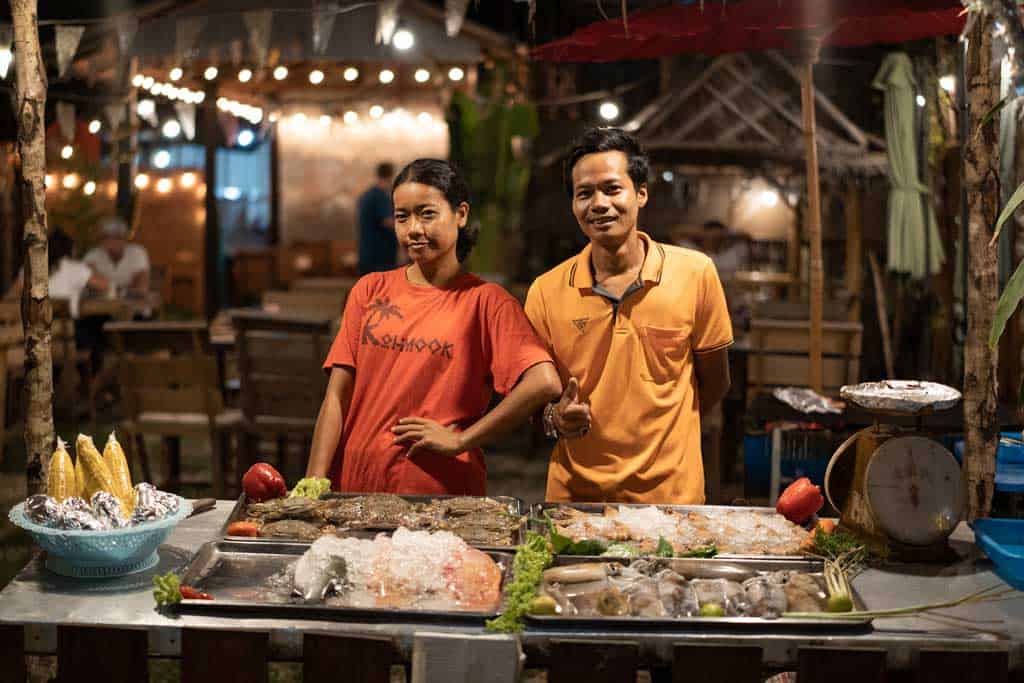
Alesha and Jarryd
Hi, We’re Alesha and Jarryd!

We’ve been traveling the world together since 2008, searching for the planet’s best destinations and adventures.
Love Travel?
Sign up for our free weekly newsletter for the best travel tips, ideas and deals!
We respect your privacy. Unsubscribe at any time.
READ MORE...
Quark Ultramarine Review – Best Polar Expedition Ship [2024]
30 Awesome Things to Do in Easter Island
The Land of Spears and Smiles – Wogasia Spear Festival on the Solomon Islands
Related Posts
Maximon – our search for the elusive cigar-smoking, rum-drinking mayan god, 8 secrets on how to survive long term travel, how to survive a head-on bus crash, akademik ioffe review – the world’s best polar cruise ship, 5 thoughts on “sustainable tourism in thailand – ecotourism, wildlife and culture guide”.
thank you for helping me with my school
You are welcome. So glad we could help. 🙂
Thank you so much!!!!!!!!!!!!!!!!!
I loved reading all your sustainable recommendations. I am planning to visit Thailand sometime next year, so this is super useful and informative! The elephant sanctuaries are on my list.
So glad you found the article helpful. It is so important to travel sustainably and know about the tours and the companies that you go with. Hope you have a great trip next year to Thailand. It is an amazing country. Definitely do your research on the elephant sanctuary. They can easily name themselves this but sometimes they are not a sanctuary. There is no one monitoring this in Thailand. Have a good one.
Leave a comment Cancel reply
Save my name, email, and website in this browser for the next time I comment.
May Term Thailand
Effects of tourism on thailand.
By Rylee Adkison and Erin Macinnis
Thailand has become one of the biggest booming areas for tourism lately and all in good reason as thailand is home to amazing beaches, greenery, and fun! Thailand has so much to offer but specific landmarks in thailand have been getting hit harder than others in terms of the rising numbers of tourist populations. There have been some positive and negative effects on some popular thai cities. Tourism can offer countries an economic boost but can have other adverse effects such as impacting the environment and destroying some beautiful landmarks. Some specific places that are being hit the hardest include Koh Tachai, koh phi phi island and the infamous maya bay. (below)

“over tourism” in thailand has been wreaking havoc on the beautiful scenery and ecosystems that the local beaches procure. Some beaches have even closed because the amount of tourists have been exceeding the max population for too long ; maya bay in specific 820 feet long and it sees about five thousand visitors each and every day. Some of the effects this has had on May bay is the “ decimation of entire ecosystems on these islands: Their beaches and waves have become littered with trash , their reefs severely damaged by irresponsible snorkelers and boats (Maya is estimated to have lost 80 percent of its coral cover), and marine life virtually wiped out as a result”. This beach has been a spot for many tourists since the 2000 film “the beach” and as progressed into such a popular spot for tourism that the local thai government had to issue a “ temporary tourist ban” but has denounced that since with closing the beach indefinitely to restore what once was.
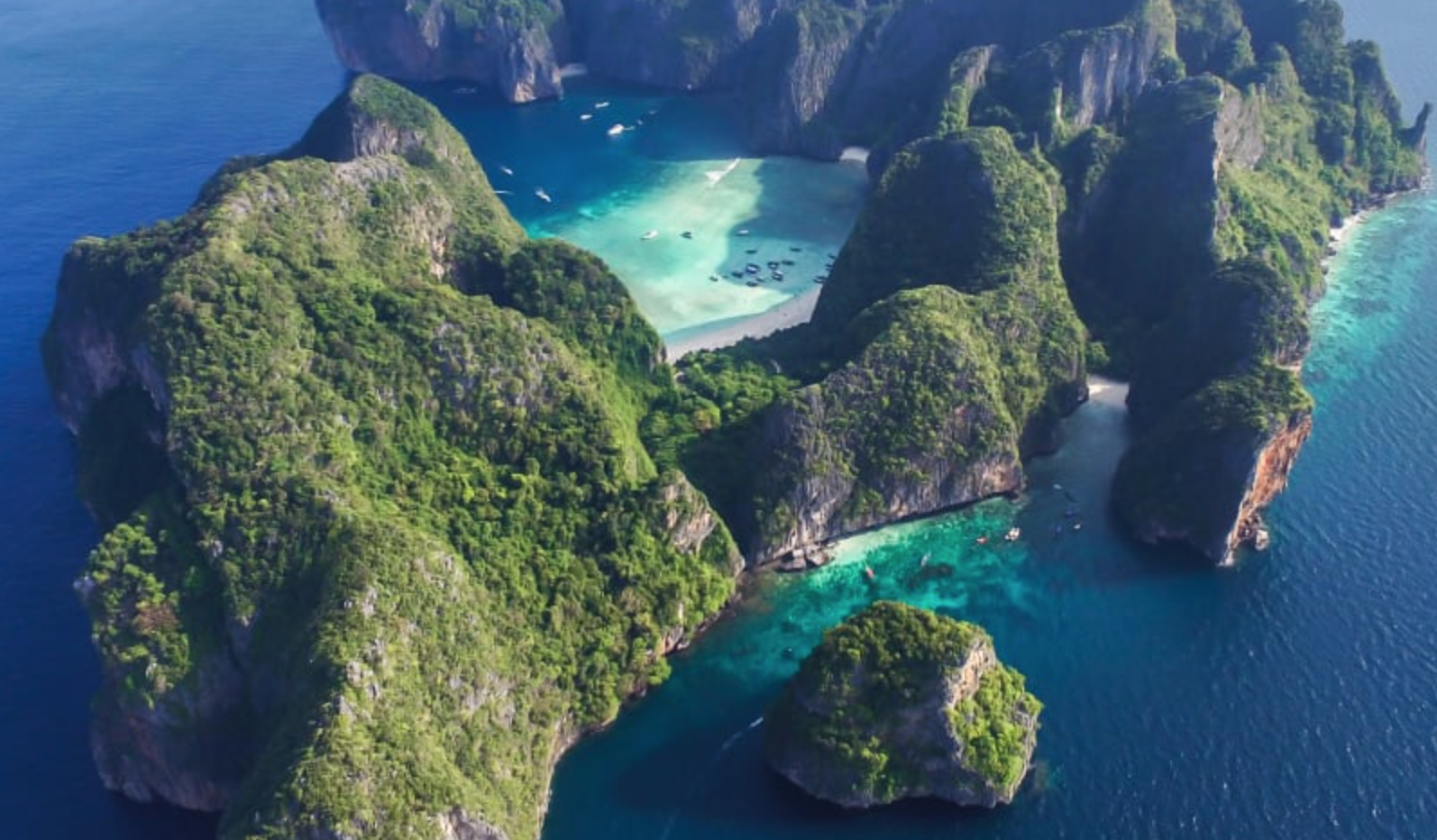
Wildlife has also been majorly affected by tourism. Specifically in Chiang Mai, elephant rides are becoming more and more popular. Although these rides are fun for tourists and throw more money into the Thai economy, they are ethically questionable. The elephants are kept in captivity and chained up in between rides. In addition, they are subjected to all kinds of abuse brought on by their mahouts, which are supposed to be the people that care for them. Elephants are supposed to be able to free roam and act as they please, but being used recreationally takes away their ability to do these things.
Another serious issue that has resulted from Thai tourism is the exponential growth of sex work and human trafficking. Although it is beyond the tourist’s control, many people are roped into the industry either voluntarily or involuntarily. According to the UN’s refugee agency in 2013, there were at least three million migrant workers in Thailand. The majority of these workers are involved in the sex industry. While walking through Patpong Market, a popular location for sex workers, you will hear western languages being spoken. You will hear more English and Spanish than Thai and Khmer. Sex trafficking in Thailand is a developing problem and there is little incentive to enforce laws against it.
There are many negative effects of tourism, especially in thailand in the last decade, but there are also many positive effects. Tourism doesn’t only do the obvious of bringing in cash but also benefits the “country’s transport systems, electricity supply and telecommunications.” Tourism can also offer places like thailand an increase in jobs for the locals which will in turn not only bring in money, but will give back to the thai community as a whole. Overall as there are many negative effects of tourism in thailand there can also be positive ones as long as the local government is keeping up with the demand for protection of the most beautiful places there country has to offer.
Tigtag UK. (2019). Tourism in Thailand. [online] Available at: https://www.tigtagworld.co.uk/film/tourism-in-thailand-PRM00784/ [Accessed 10 May 2019].
Editors, C. (2019). 15 Beloved Places Struggling With Overtourism. [online] Condé Nast Traveler. Available at: https://www.cntraveler.com/galleries/2015-06-19/barcelona-bhutan-places-that-limit-tourist-numbers [Accessed 10 May 2019].
CNN Travel (2019). Thailand Bay made popular by ‘The Beach’ to remain closed for two more years. [online] Available at: https://www.cnn.com/travel/article/maya-bay-closure-thailand/index.html [Accessed 10 May 2019].
Valenta, K. (2019). The Dark Side of Tourism in Thailand. [online] Oyster.com. Available at: https://www.oyster.com/articles/60615-the-dark-side-of-tourism-in-thailand / [Accessed 10 May 2019].
Share this:
Leave a comment cancel reply.
This site uses Akismet to reduce spam. Learn how your comment data is processed .
Website Built with WordPress.com .

- Already have a WordPress.com account? Log in now.
- Subscribe Subscribed
- Copy shortlink
- Report this content
- View post in Reader
- Manage subscriptions
- Collapse this bar

Thailand Working to Boost Tourism With New Tax Measures
Thailand ’s government on June 4 approved a new tax break for companies organizing local conventions and seminars to boost domestic tourism during the country’s low tourism season.
According to Reuters , the tax deductions will cost the government 1.5 billion baht in tax revenue, which is equivalent to $41 million U.S. dollars, but the positive impact on the tourism economy would be greater.
The tax deductions are also available for those booking homestay and non-hotel accommodations.
According to Deputy Finance Minister Paopoom Rojanasakul, the new domestic travel incentives for businesses will extend from May through November.
The World Travel & Tourism Council’s economic data on the tourism industry in Thailand reports that the industry comprises 13 percent of the country’s total Gross Domestic Product and employs nearly 8 million Thai people across the country this year.
While international visitor spending is expected to continue being around 13 percent lower than Thailand’s 2019 average, domestic visitor spending is expected to grow 10.7 percent year over year, over 11.5 percent over its pre-pandemic level. In fact, domestic spending now comprises just under 50 percent of all travel and tourism in Thailand.
That doesn’t mean Thailand isn’t trying to boost its international numbers , though. At the end of May, the country announced an extension of the visa-free travel period from 30 to 60 days, along with an increase in the number of countries eligible to visit visa-free, among other new incentives.
Digital nomads, remote workers, and freelancers can also stay in Thailand even longer, extended to 180 days.

- My View My View
- Following Following
- Saved Saved
Thailand targets tourism boost with longer stays for visitors, students, 'digital nomads'
- Medium Text

Sign up here.
Reporting by Panarat Thepgumpanant and Chayut Setboonsarng; Editing by Martin Petty
Our Standards: The Thomson Reuters Trust Principles. New Tab , opens new tab
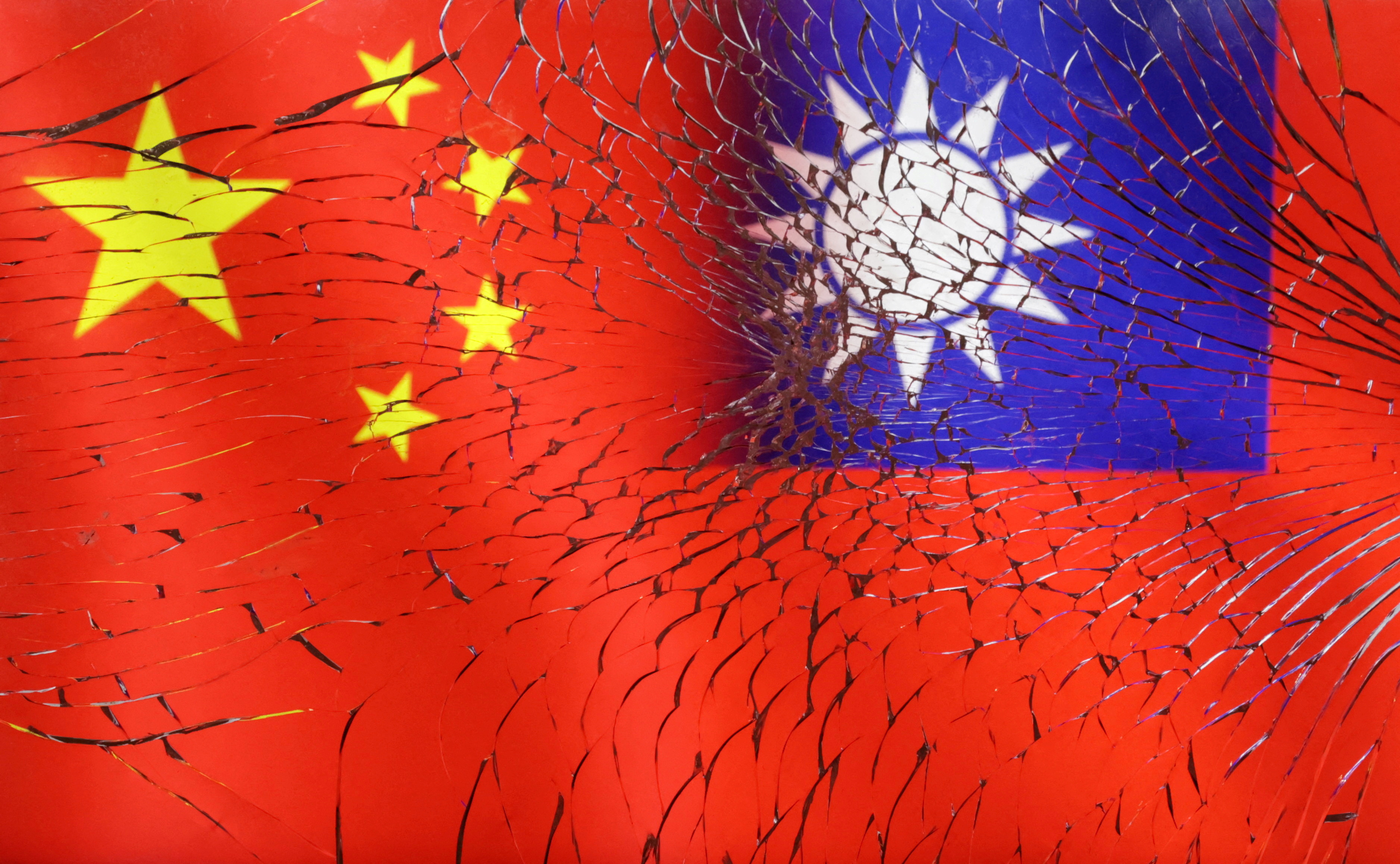
World Chevron

Russia races to save entangled humpback whale in the Arctic
Russian marine specialists are racing to save a humpback whale which has become entangled in a fishing net north of the Arctic circle.
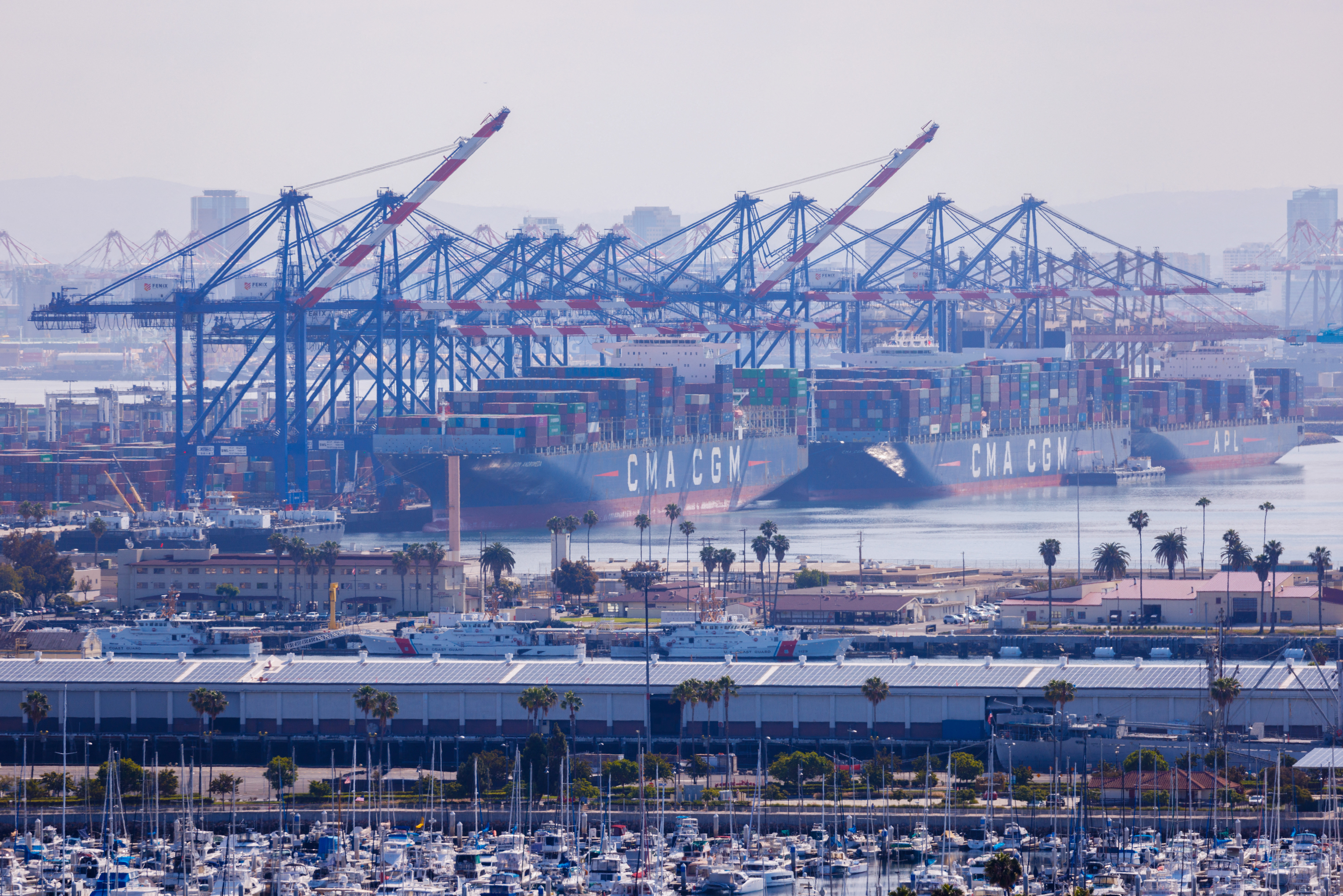

IMAGES
VIDEO
COMMENTS
As the film's popularity grew, so too did tourists' desire to visit the location where much of it was shot - Maya Bay. Over the years, the number of tourists increased from less than 1,000 ...
Tourism made up 20.6 percent of Thailand's GDP in 2016 and supported about 6.1 percent of jobs. Bangkok, Thailand's capital, was the most visited city in 2017. It is clear the tourism in Thailand is impacting the country. ... Tourism's Impact on the Environment. With tourism in Thailand increasing, trash increases as well. Unfortunately ...
Thailand's tourism industry, once a beacon of economic prosperity, has experienced a rollercoaster of highs and lows. The late 1980s and early 1990s marked an era of unprecedented growth, with the country becoming a must-visit destination for travellers worldwide. However, this boom was not without its consequences.
The current state of Thailand's tourism industry. In 2023, the total revenue incurred from both local and international tourists in Thailand amounted to over 2.17 trillion Thai baht, with ...
The country's revenue from domestic travel dropped from $34.5 billion to $15.4 billion in 2020. An increase in domestic spending alone would not compensate for the impact of the pandemic on the Thai economy. The country has largely been dependent on international markets, which represented about $62 billion or 60 percent of total tourism ...
Thailand has shown a gradual economic recovery from the COVID-19 pandemic during 2022, helped by rising international tourism arrivals. Real GDP growth rose from 1.5% in 2021 to 2.6% in 2022, with growth momentum expected to improve further in 2023. The latest S&P Global Thailand Manufacturing PMI survey results for February 2023 continued to ...
23.11.2023. Statistics & Trends. Thailand's tourism faces challenges from global events and shifting visitor demographics, impacting local communities and environmental sustainability. Thailand, renowned for its dynamic capital Bangkok, exquisite temples, pristine mountainous regions, and a myriad of idyllic islands, has long been a staple in ...
Despite the strong recovery so far, Thailand's tourism industry is still a long way from the pre‑covid levels when annual arrivals regularly exceeded 30m. The total number of arrivals in January-August this year is only 17% of that in the same period in 2019. The composition of arrivals by nationality sheds light on the cause of the weakness.
In 2019, Thailand earned 90 billion US$ from domestic and international tourism, but the pandemic caused revenues to crash to 24 billion US$ in 2020. 4 Phuket was ranked the 15 th most-visited place in the world 5 and previously had >10.5 million international tourists creating over 13 billion US$ income, which is close to 90% of the local GDP ...
Thailand's strict COVID measures meant international travel has ground to a halt during the pandemic. But now, with tourism set to start up once again, the country is not sure it wants the same ...
For an economy whose staple is travel, Thailand's tourism industry is taking a major hit amid the COVID-19 pandemic. Tourism is a major economic contributor to Thailand, with tourist receipts accounting for 11.5% of GDP in 2019, more than doubling from 5.2% in 2009. In addition, Chinese tourists account for the lion share of tourist arrivals, clocking 27.5% in 2019, followed by Malaysia (10. ...
In 2019, Thailand welcomed a record high of 40 million visitors. For this reason, tourism is a major driver of Thailand's economic development, providing around 20% of the national GDP and employing over 4.2 million people (11% of total employment). However, Thailand's tourism industry is not without negative side effects.
Tourism significantly impacts Thailand's local economy as one of the main contributors to the annual GDP. However, it is crucial for the country to strike a balance between economic benefits and managing the number of tourists to prevent negative effects of overtourism. Monday, June 3, 2024. My Account. Account details;
GDP was over 5%, and in 2018, it was over 12%. The. number of tourists reached over 38 million in 2018, representing an increase of 172 times of the 1960. figure (T ourism Authority of Thailand ...
The economies of countries dependent on tourism are clearly hurting, with visitor numbers plummeting as a result of the pandemic. In Thailand alone, a country where tourism accounts for 11%-12% of ...
Thailand, the Land of Smiles, has firmly cemented itself as one of the most popular tourist destinations on the planet. With 39 million people visiting the Southeast Asian nation in 2019, the word is well and truly out on just how magical Thailand really is.. The international tourism industry in Thailand really started back in the 1970s, when travellers made their way here along the old ...
Thailand's plans to manage tourism at Maya Bay. Natalie Muller | Neil King. 04/23/2021. Thai authorities want to cap the number of tourists at Maya Bay to rescue its stressed marine ecosystem. The ...
Chinese tourists are no longer to be the key role of Thailand tourism. With stunning impacts caused by the COVID-19 pandemic, it seems no way out of this problem to revival tourism sectors in the country. A solution to refresh Thailand tourism comes from deeply looking back to domestic travels. This research article was one of pilot projects to ...
There are many negative effects of tourism, especially in thailand in the last decade, but there are also many positive effects. Tourism doesn't only do the obvious of bringing in cash but also benefits the "country's transport systems, electricity supply and telecommunications.". Tourism can also offer places like thailand an increase ...
BANGKOK, Oct 10 (Reuters) - Thailand's economic recovery will not be affected by a global slowdown due to a rebound in tourism, Finance Minister Arkhom Termpittayapaisith told reporters on Monday ...
Global slowdown, delay in government formation among risks. BANGKOK, July 31 (Reuters) - Thailand's economic recovery remained on track in June as the tourism sector expanded on higher foreign ...
2:10. Thailand is counting on 1 million more foreign tourist arrivals and faster government spending to help boost economic growth this year to the fastest pace in six years. The country targets ...
There are numerous positive and negative effects of tourism on Thailand's environmental, social and economical situation. The most recent and obvious impact on Thailand's economy has been the Tsunami disaster on 26 th December 2004. The result of this disaster, according to Thadani, M (2005), will see the decline in the number of tourists ...
Thailand 's government on June 4 approved a new tax break for companies organizing local conventions and seminars to boost domestic tourism during the country's low tourism season. According ...
Thailand recorded 14.3 million tourists in from January to May 26 this year and is targeting a record 40 million foreign arrivals for the full year, with revenue of 3.5 trillion baht ($95.73 ...
Saturday, 08 Jun 2024. 10:52 AM MYT. - The Nation/ANN. BANGKOK: Around one in ten children under five years old in Thailand experience severe food poverty which threatens their health and overall ...
The 2022 Revision of World Population Prospects is the twenty-seventh edition of official United Nations population estimates and projections that have been prepared by the Population Division of the Department of Economic and Social Affairs of the United Nations Secretariat. It presents population estimates from 1950 to the present for 237 countries or areas, underpinned by analyses of ...